NTT CS Labs.
13:30- February 27, 2013
「色依存のフレーザー・ウィルコックス錯視におけるプルキンエシフト様の現象」
Color-dependent anomalous motion illusion and its reversal
Akiyoshi Kitaoka, Ritsumeikan University / JST CREST
since February 26, 2013 Handout
Warning: This page includes real animations. Please do not keep watching them for a long time. Although this page has carefully avoided the known harmful stimuli, unknown ones might happen to be included. Never copy them.
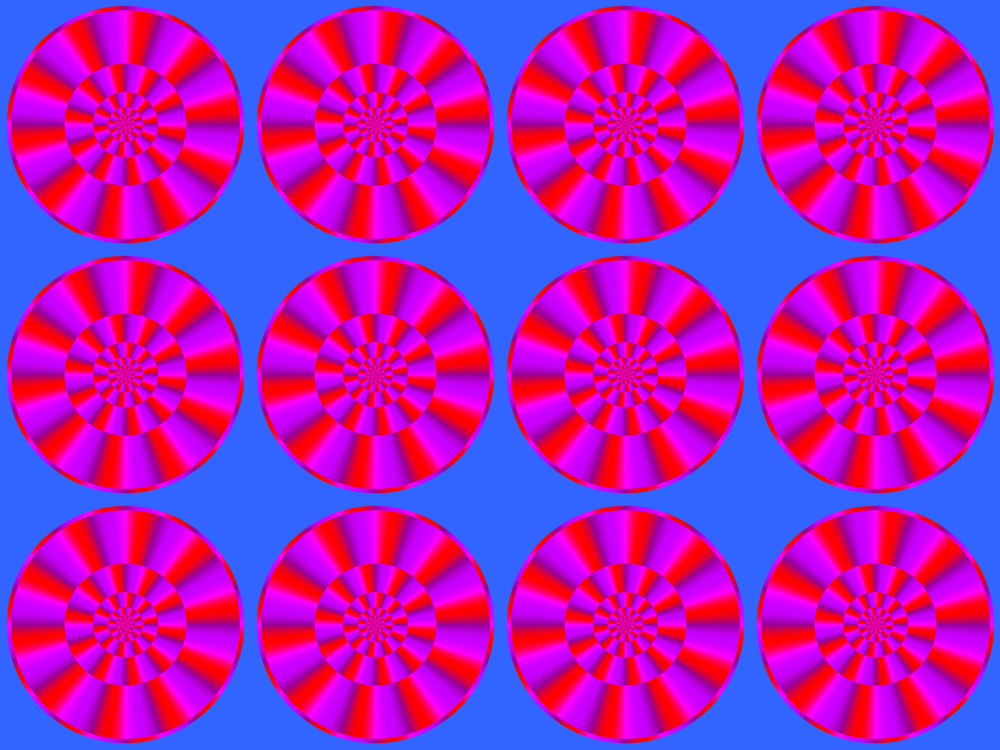
"Rotating red
disks"
Each disk appears to rotate clockwise when this image is presented on a bright PC display or in a print with a bright environment.
Copyright Akiyoshi Kitaoka 2013 (January 17)
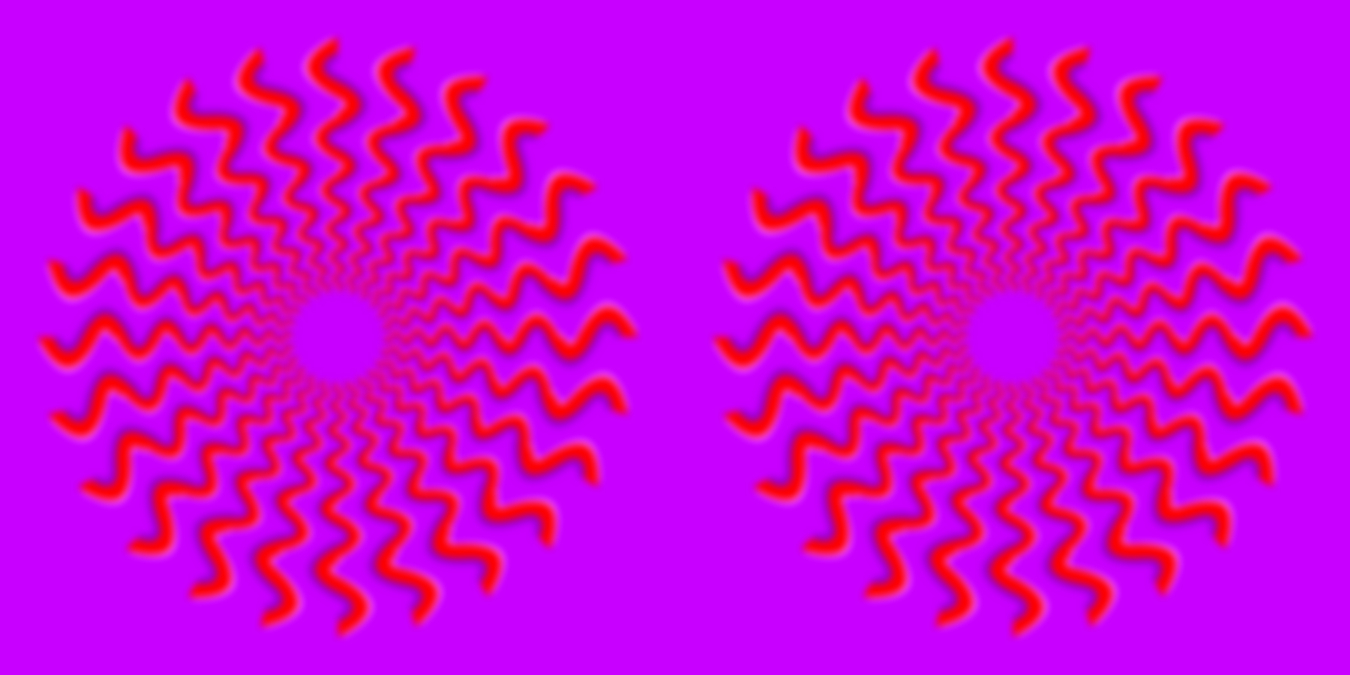
"Fudo-myo-o 2012"
Each disk appears to rotate clockwise when this image is presented on a bright PC display or in a print with a bright environment.
Copyright Akiyoshi Kitaoka 2012 (December 3)
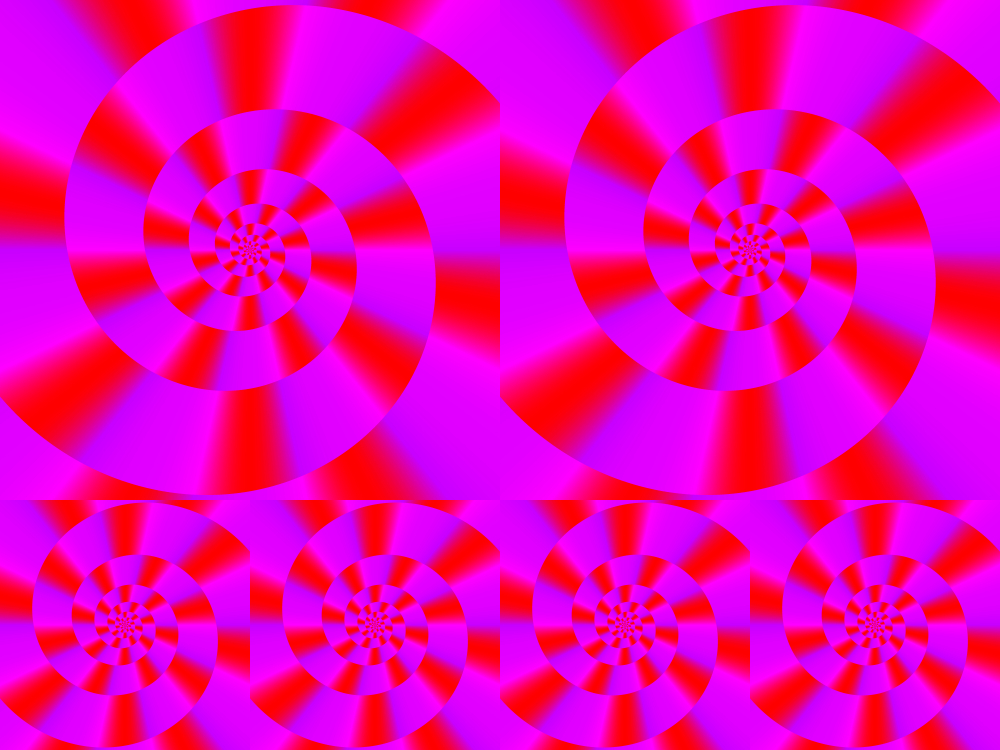
"Takonyudo"
takonyudo = octopus
Each disk appears to rotate counterclockwise when this image is presented on a bright PC display or in a print with a bright environment.
Copyright Akiyoshi Kitaoka 2009 (January 11)
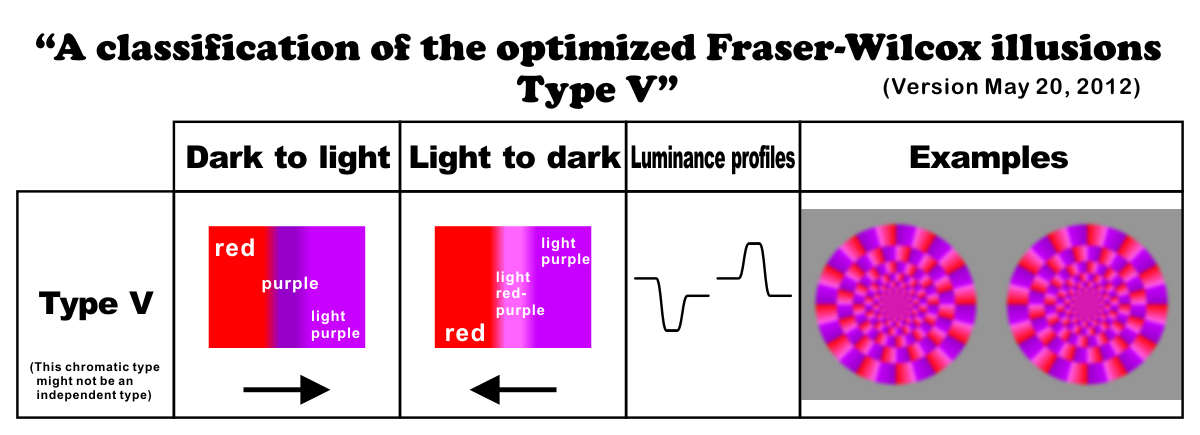
Copyright Akiyoshi Kitaoka 2012 (May 20)
"Rotating red
disks"
Each disk appears to rotate counterclockwise when this image is presented in a printed image with a dark environment.
Copyright Akiyoshi Kitaoka 2013 (January 17)
References
Yanaka, K. (2012). Enhancement of the optimized Fraser-Wilcox illusion Type V by swinging the image. Talk in the 5th Illusion Workshop, Meiji University, Tokyo, Japan, September 18, 2012.
Kitaoka, A. (2013). Invisible color and visible color: Mystery of color the brain feels. Talk in the Shizuoka Science Museum Ru-Ku-Ru, Shizuoka, Japan, January 13, 2013. Talk
A brief history of phenomenal aspects of the Fraser-Wilcox illusion group
<Kitaoka, A. (forthcoming). The Fraser-Wilcox illusion and its extension. In Shapiro, A. and Todorovic, D. (Eds.), Oxford Compendium of Visual Illusions. Oxford University Press.>
1. Fraser and Wilcox (1979)
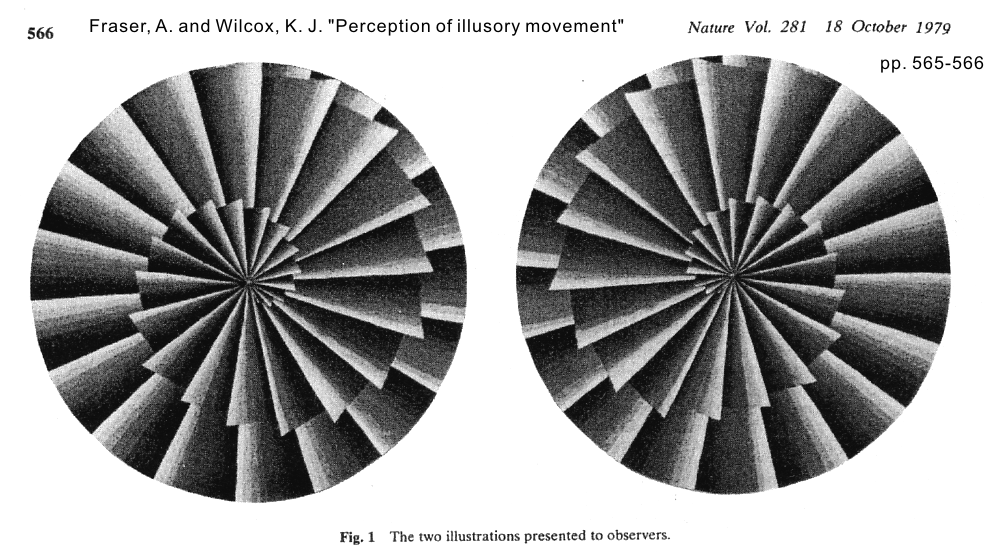
References
Fraser, A. and Wilcox, K. J. (1979). Perception of illusory movement. Nature, 281, 565-566.
Observers saw illusory motion in a stationary image which consists of repeated luminnace gradient in a saw-tooth wave form. Some reported illusory motion from dark to light along a luminance gradient, while others saw the reversal. The illusion is strong in the peripheral viewing. Fraser and Wilcox (1979) claimed that this individual difference depends on some genetic properties.
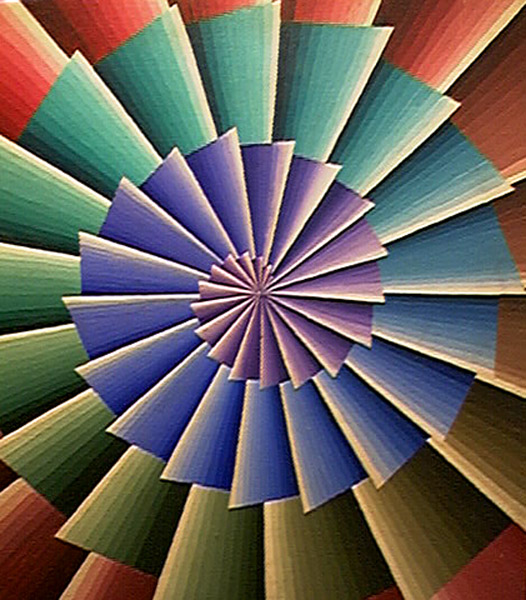
Adopted from “Alex Fraser, Geneticist and Painter”
(http://doctoralexfraser.blogspot.jp/p/spirals.html) <access August 25, 2012> (with permission from Alan Fraser)
Alex Fraser (1923-2002) was a geneticist and a painter.
2. Faubert and Herbert (1999)
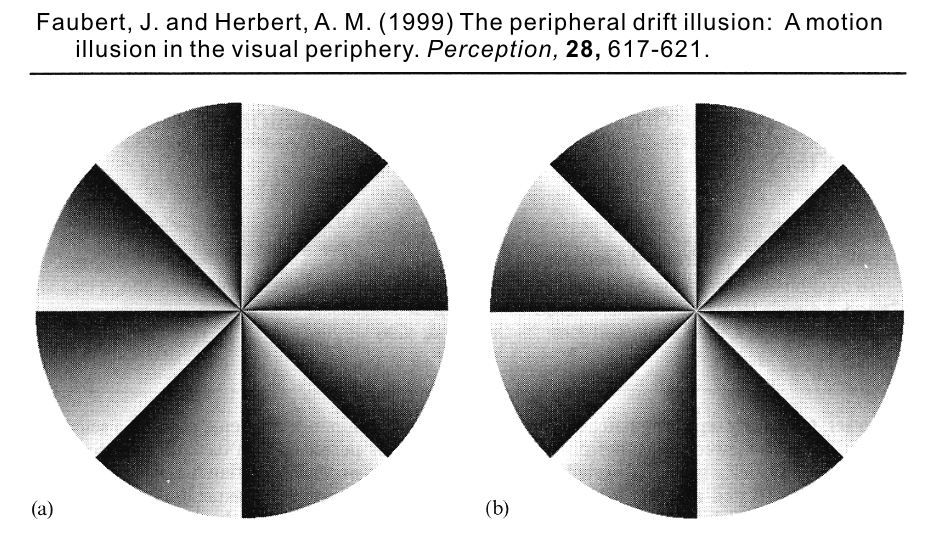
The left disk appears to rotate clockwise while the right one counterclockwise. Faubert and Herbert (1999) reported only illusory motion from dark to light along a luminance gradient. They attributed the illusory motion to the assumed time difference between responses to black and white.
References
Faubert, J. and Herbert, A. M. (1999). The peripheral drift illusion: A motion illusion in the visual periphery. Perception, 28, 617-621.
3. Naor-Raz and Sekuler (2000)
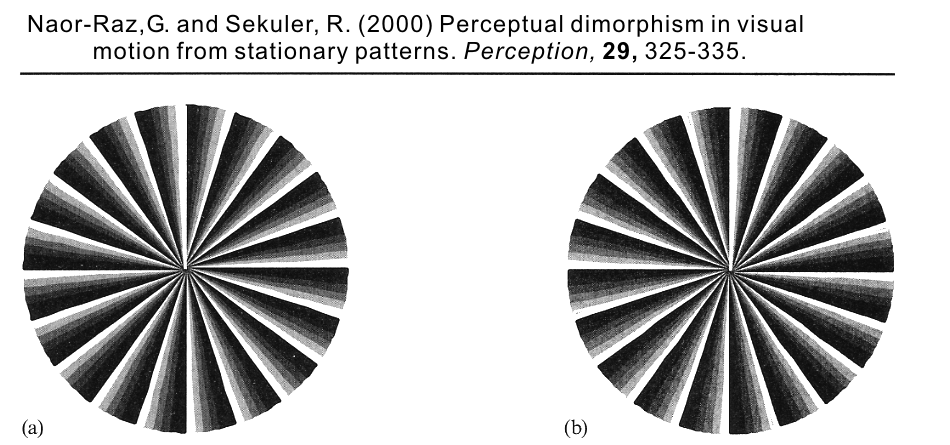
The left disk appears to rotate clockwise while the right one counterclockwise. Naor-Raz and Sekuler (2000), too, reported only illusory motion from dark to light along a luminance gradient. They revealed that the illusion magnitude is a positive, nearly linear function of contrast.
References
Naor-Raz, G. and Sekuler, R. (2000). Perceptual dimorphism in visual motion from stationary patterns. Perception, 29, 325-335.
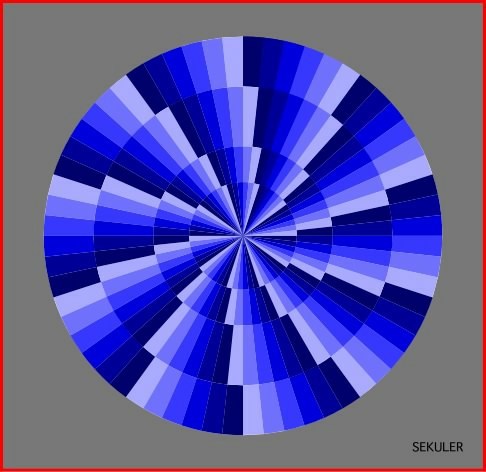
This disk appears to rotate clockwise.
This color illusion image presented by Naor-Raz and Sekuler (2000) (shown
below) might be attributable to this type.
http://www.perceptionweb.com/perception/perc0300/sekuler.jpg <access August 26, 2012>
<with permission from Robert Sekuler>
4. Kitaoka and Ashida (2003)
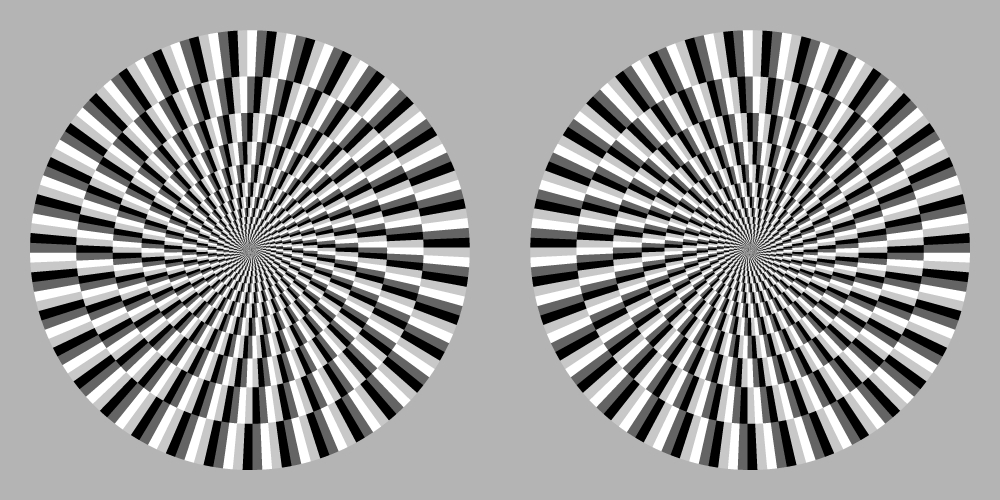
The left disk appears to rotate counterclockwise while the right one clockwise. Kitaoka and Ashida (2003) proposed that the illusory motion is strong when patterns are arranged in the following luminance order: from black, dark-gray, white, light-gray, and back to black.
References
Kitaoka, A. and Ashida, H. (2003). Phenomenal characteristics of the peripheral drift illusion. VISION (Journal of the Vision Society of Japan), 15, 261-262. PDF
5. Kitaoka (2007)
Kitaoka (2007) classified the Fraser-Wilcox illusion into Type I, IIa, IIb and III, in each of which the dark-to-light type was distinguished from the light-to-dark one.
References
Kitaoka, A. (2007) Phenomenal classification of the “optimized” Fraser-Wilcox illusion and the effect of color. Poster presentation in DemoNight, VSS2007, GWiz, Sarasota, Florida, USA, May 14, 2007.
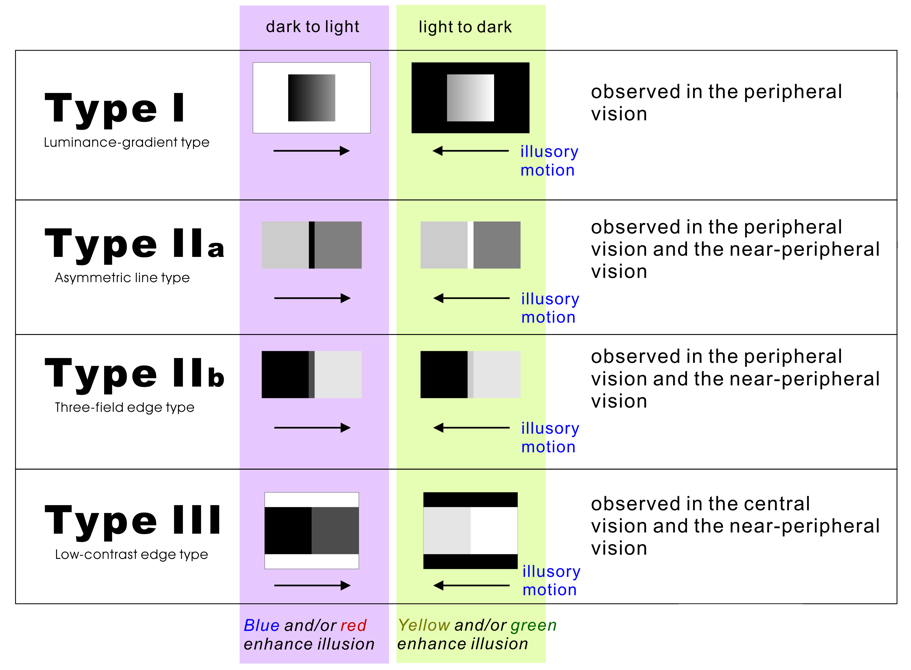
Type I
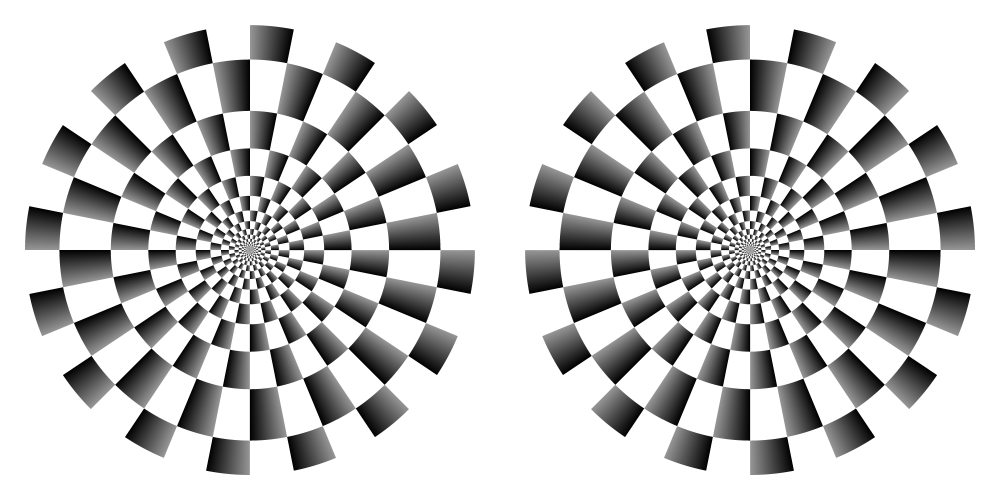
"Dark to light"
The left disk appears to rotate counterclockwise while the right one clockwise.
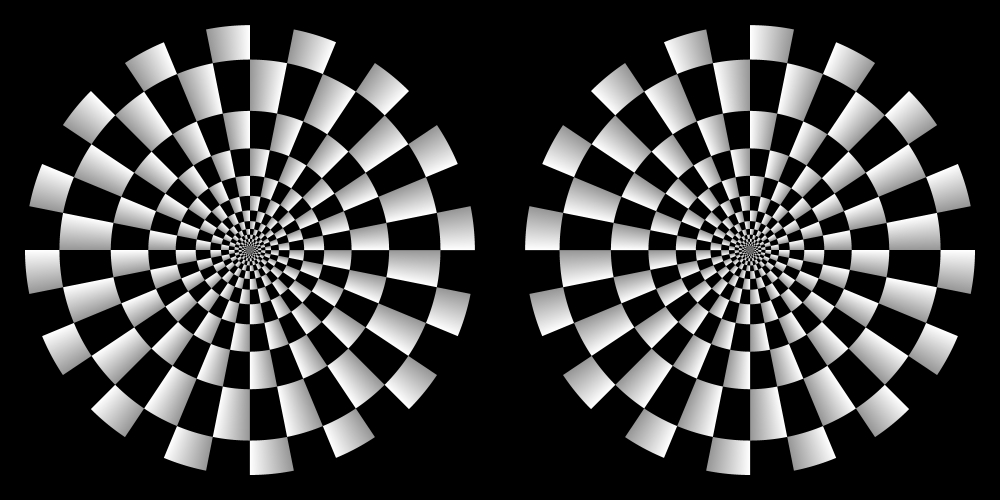
"Light to dark"
The left disk appears to rotate counterclockwise while the right one clockwise.
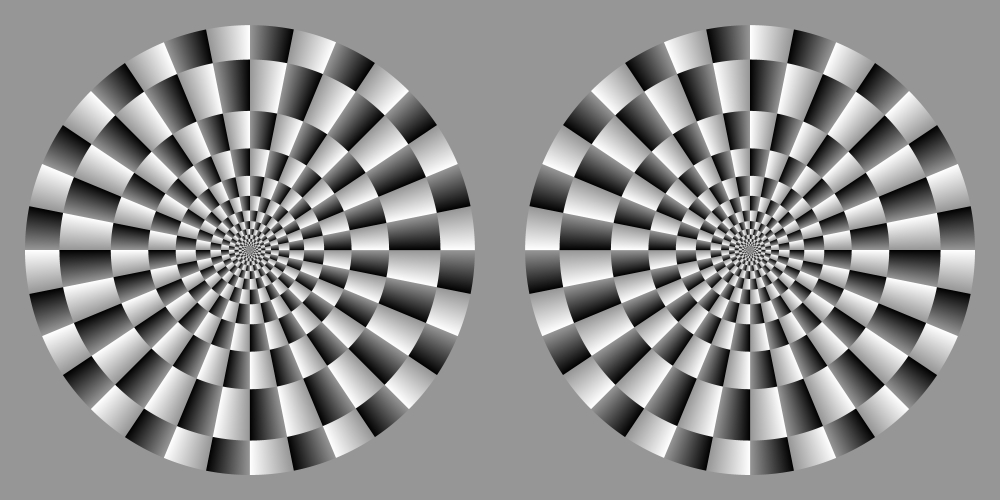
"Dark to light" and "light to dark" combined
The left disk appears to rotate counterclockwise while the right one clockwise.
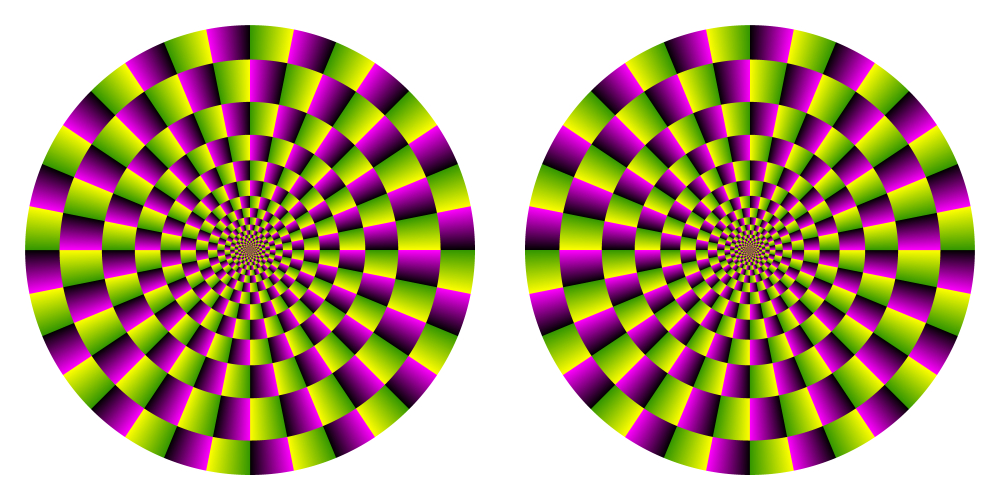
"Dark to light" and "light to dark" combined, with
color enhancement
The left disk appears to rotate counterclockwise while the right one clockwise.
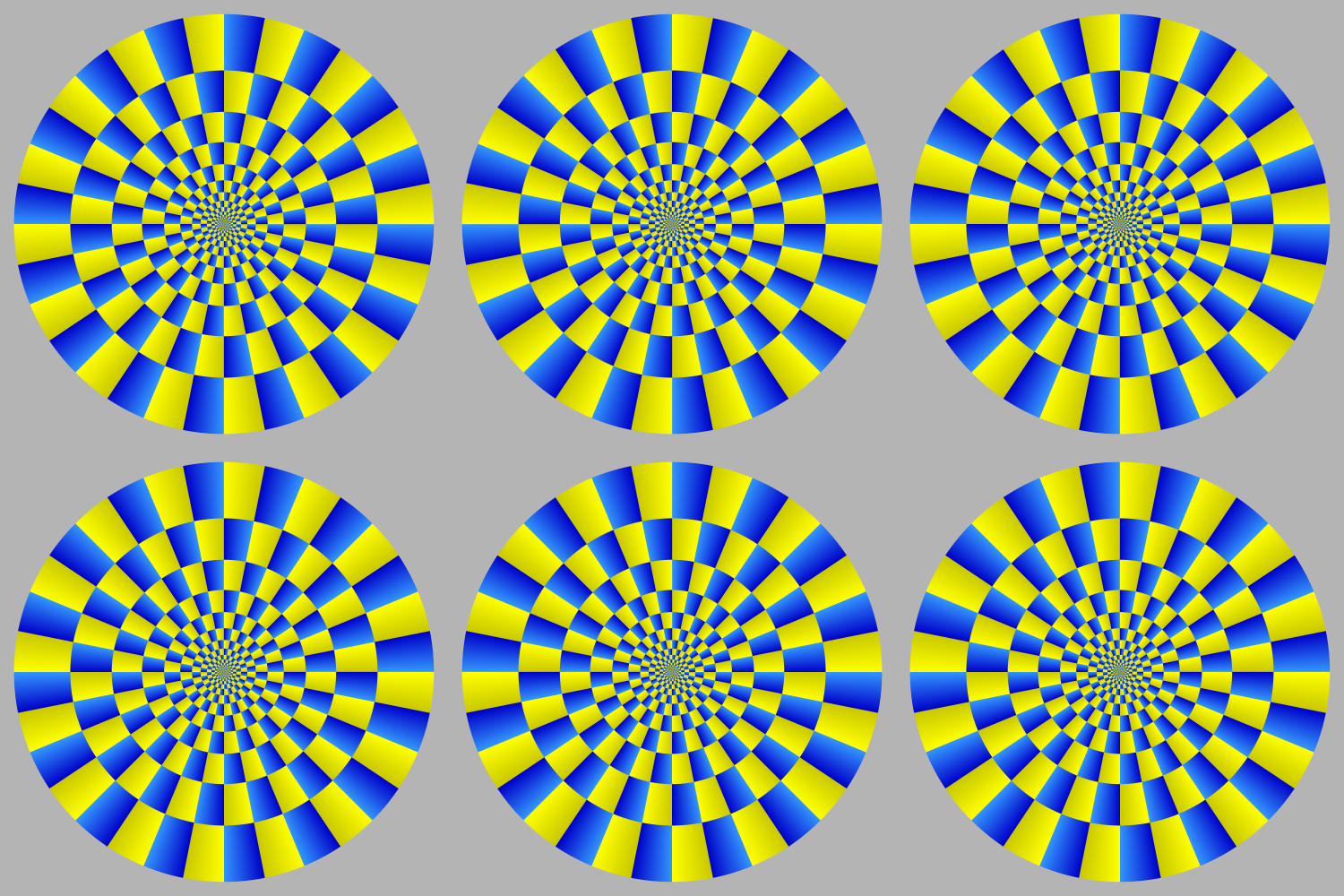
The upper-left, upper-right, and lower-middle disks appear to rotate counterclockwise
while the rest clockwise.
Type I (six disks) 1500 x 1000 (pixel)
Type I (six disks) 6000 x 4000 (pixel)
Type II
Type IIa
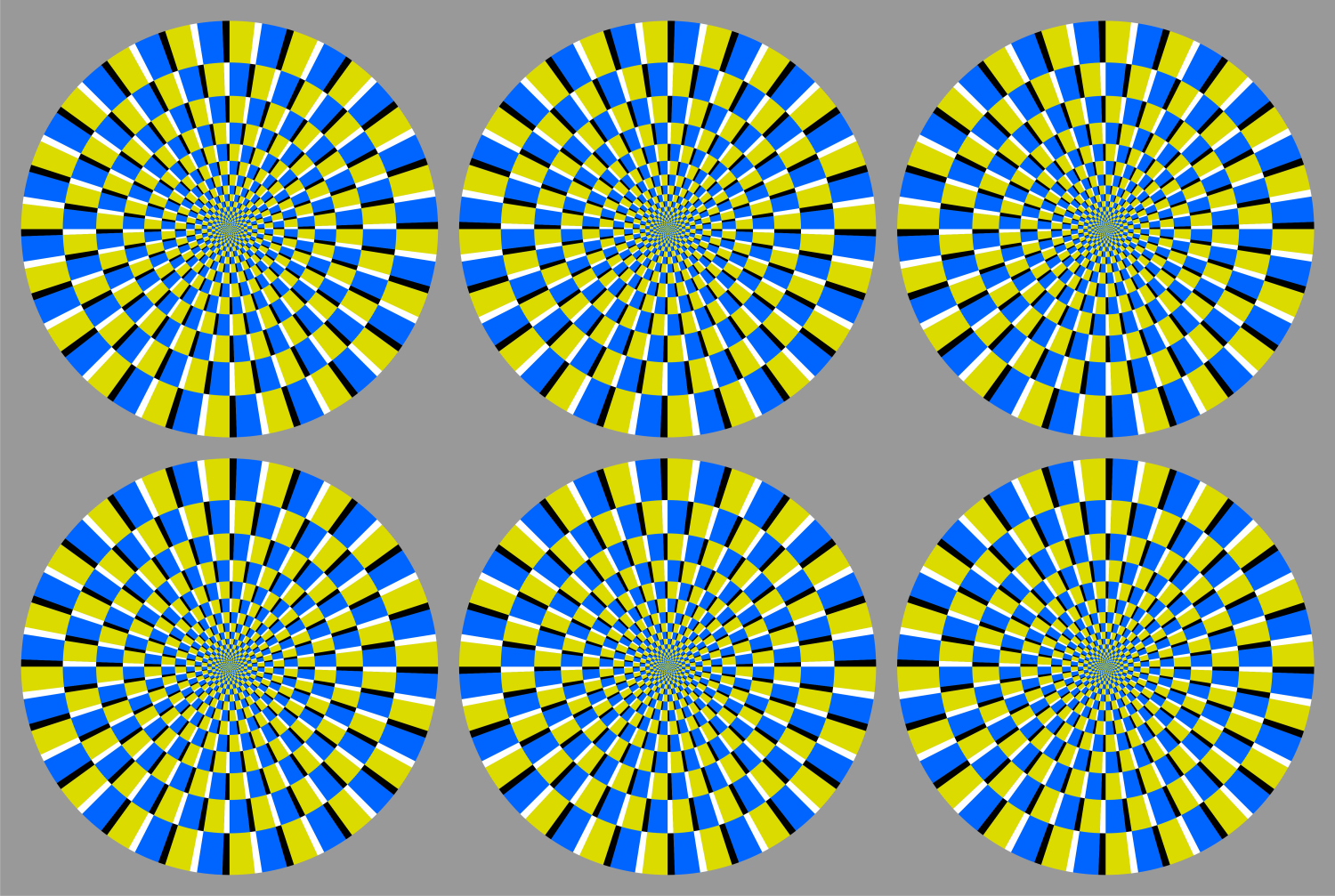
The upper-left, upper-right, and lower-middle disks appear to rotate counterclockwise
while the rest clockwise.
Type IIb
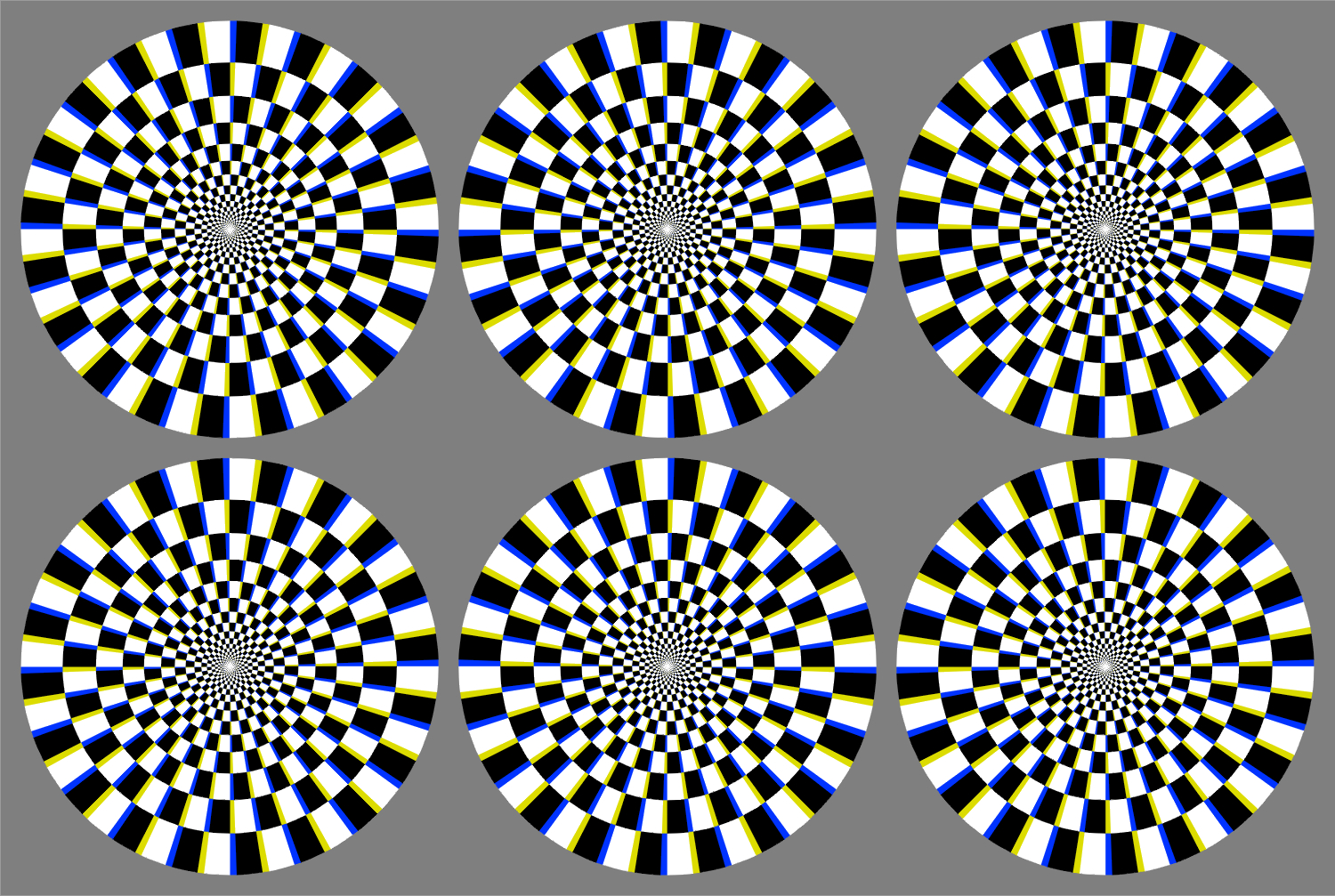
The upper-left, upper-right, and lower-middle disks appear to rotate counterclockwise while the rest clockwise.
Type IIa (six disks) 1500 x 1007 (pixel)
Type IIa (six disks) 6000 x 4031 (pixel)
Type IIb (six disks) 1500 x 1000 (pixel)
Type IIb (six disks) 6000 x 4000 (pixel)
Type III

The upper row appears to move rightward while the lower one leftward.
Type III (two rows) 1500 x 400 (pixel)
Type III (two rows) 4500 x 1200 (pixel)Type III 4500 x 1200
.jpg)
The upper-left, upper-right, and lower-middle disks appear to rotate counterclockwise
while the rest clockwise.
6. Kitaoka (2008a, b)
"Type IV" was added to the list.
References
Kitaoka, A. (2008a). Optimized Fraser-Wilcox illusions: a pictorial classification by Akiyoshi Kitaoka. Talk in Workshop No.005 "Experimental studies of anomalous motion illusions" in the 72nd Annual Convention of the Japanese Psychological Association, Hokkaido University, Sapporo, Japan, September 19, 2008. Talk
Kitaoka, A. (2008b). A new type of the optimized Fraser-Wilcox illusion in a 3D-like 2D image with highlight or shade. Journal of Three Dimensional Images (Japan), 22(4), 31-32. PDF PDF (manuscript) Presentation
Type IV
m.jpg)
The upper-left, upper-right, and lower-middle rings appear to rotate counterclockwise
while the rest clockwise.
| Type | dark to light | light to dark | Examples |
| IV new! |
 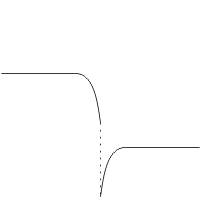 |
 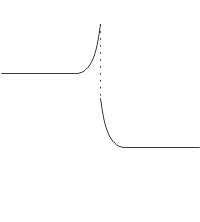 |
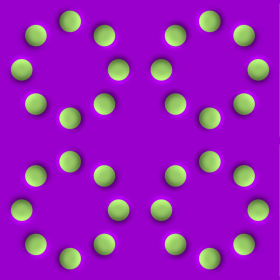 |
7. Kitaoka (2010, 2012a, b)
"Type V" was added to the list.

Black » dark-gray » white » light-gray » black
Purple » light purple » light red-purple » red »
purple
References
Kitaoka, A. (2010). Introduction to visual illusion. Tokyo: Asakura-shoten (in Japanese). Book
Kitaoka, A. (2012a). Designs using the red Fraser-Wilcox illusion. Journal
of the Color Science Association of Japan, 36, Supplement, 188-189. PDF (color manuscript) Talk
Kitaoka, A. (2012b) The Fraser-Wilcox illusion and its extension. Perception 41 ECVP Abstract Supplement, page 91 (Poster September 3, 2012). Poster PDF

"Rotating red
disks"
Each disk appears to rotate clockwise when this image is presented on a bright PC display or on a print with a bright environment.
Copyright Akiyoshi Kitaoka 2013 (January 17)
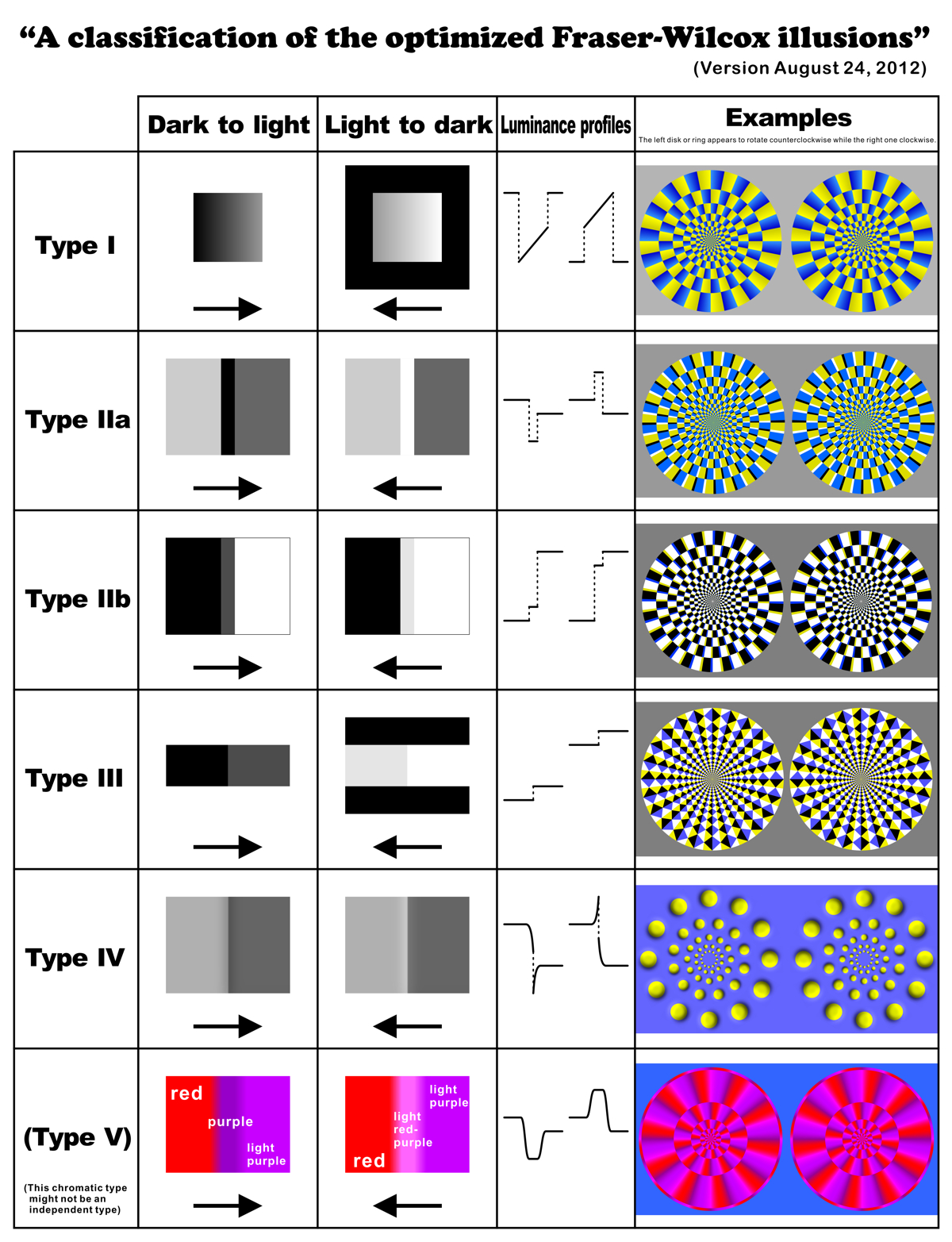
8. Kitaoka (2011)
「フリッカー不動明王」
左右の円盤は時計回りに回転して見える。
Copyright Akiyoshi Kitaoka 2012 (June 14)
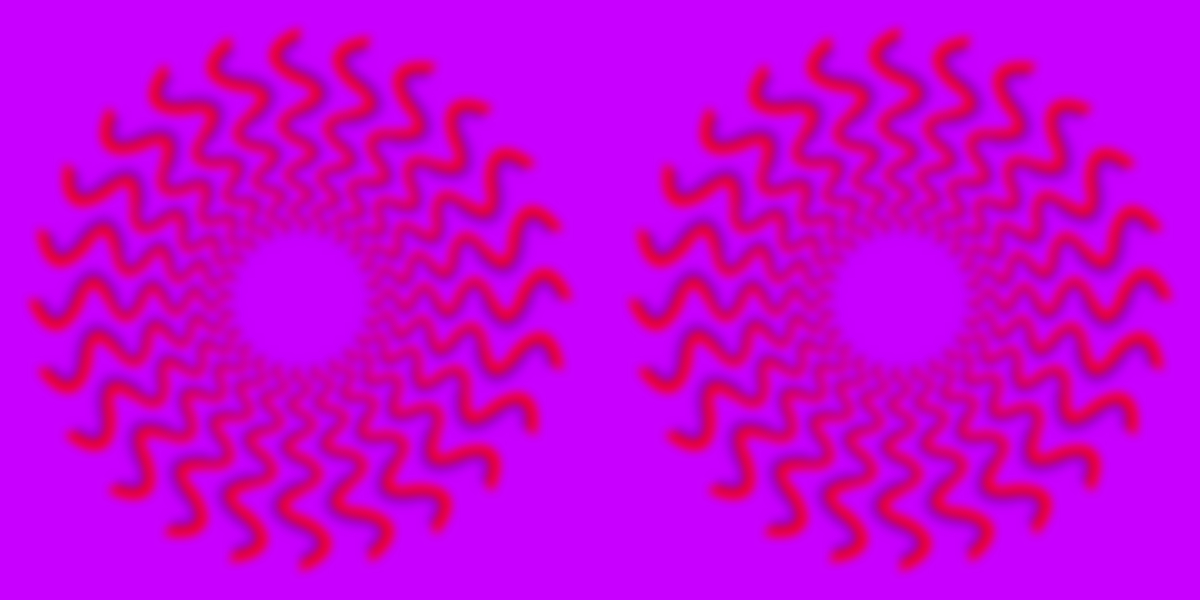
「不動明王」
左右の円盤は時計回りに回転して見える。
Copyright Akiyoshi Kitaoka 2011 (August 29)
9. Yanaka and Hirano (2011)
Yanaka and Hilano (2011) reported that the Type V illusion is enhanced by mechanical shaking.
Each disk appears to rotate counterclockwise.
(Note that this movie is not their original)
References
Yanaka, K. and Hilano, T. (2011). Mechanical shaking system to enhance
"Optimized Fraser–Wilcox Illusion Type V". Perception, 40, ECVP
Abstract Supplement, page 171.
10. Yanaka (2012)
Yanaka (2012) reported that the Type V illusion is enhanced by viewing images under dark illumination.
(Note that this movie is not his original)
References
Yanaka, K. (2012). Enhancement of the optimized Fraser-Wilcox illusion Type V by swinging the image. Talk in the 5th Illusion Workshop, Meiji University, Tokyo, Japan, September 18, 2012.
11. Kitaoka (2013)
Kitaoka (2013) reported that the direction of illusory motion of the Type V illusion in a printed image is reversed under dark illumination.
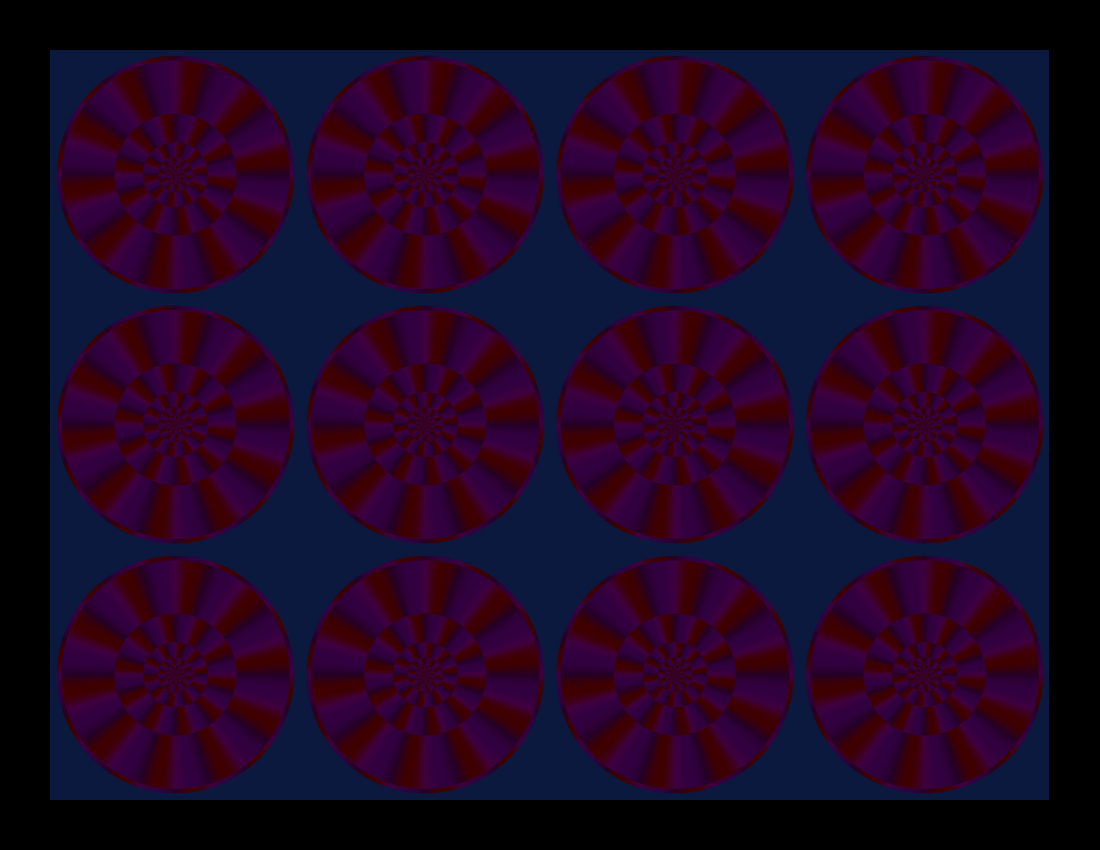
Each disk appears to rotate counterclockwise in a printed image. PC displays
or projector-projected images show weak effects.
References
Kitaoka, A. (2013). Invisible color and visible color: Mystery of color the brain feels. Talk in the Shizuoka Science Museum Ru-Ku-Ru, Shizuoka, Japan, January 13, 2013. Talk
12. Kitaoka (2013)
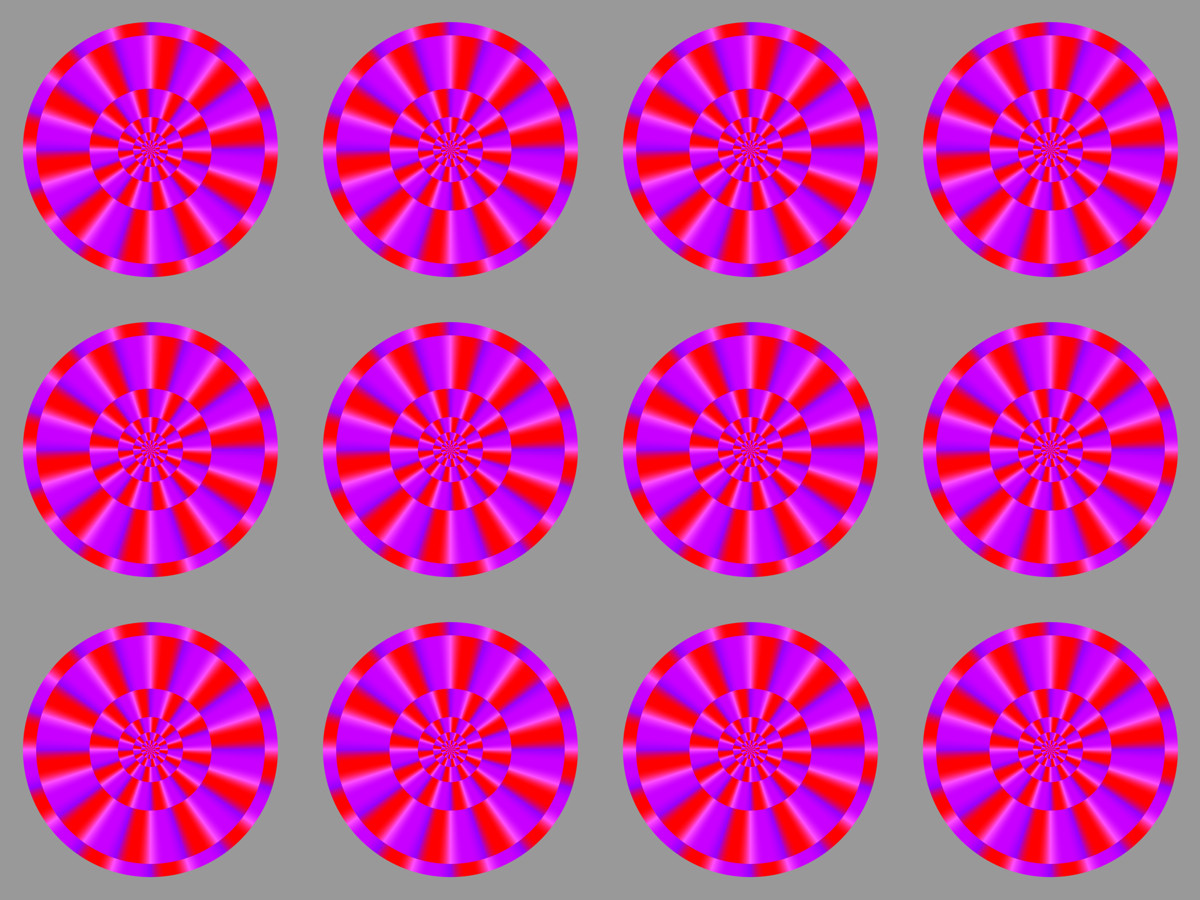
"Rotating red-and-purple disks"
Each disk appears to rotate clockwise on a bright display, while it appears to rotate counterclockwise with a printed image under dark illumination.
Copyright Akiyoshi Kitaoka 2013 (February 6)
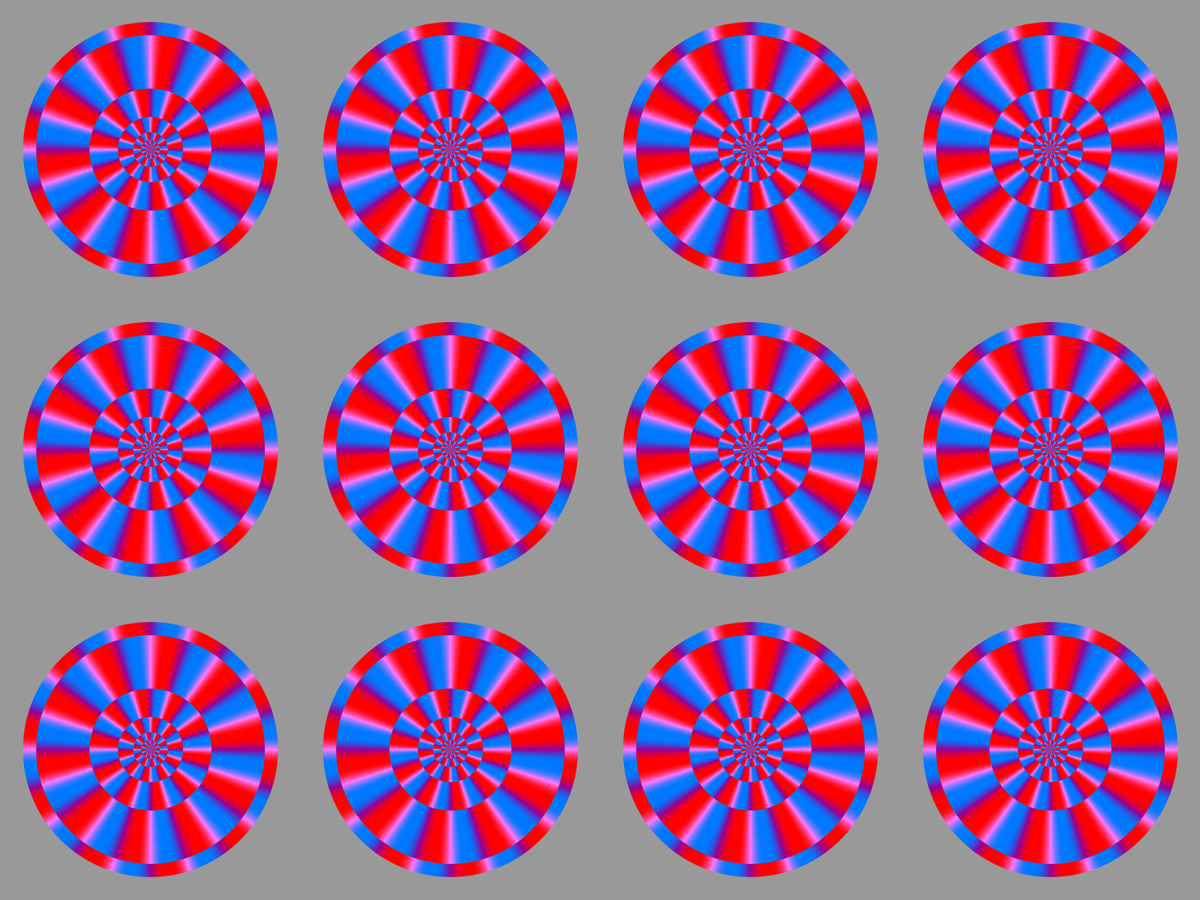
"Rotating red-and-cyan disks"
Each disk appears to rotate clockwise on a bright display, while it appears to rotate counterclockwise with a printed image under dark illumination.
Copyright Akiyoshi Kitaoka 2013 (February 1)
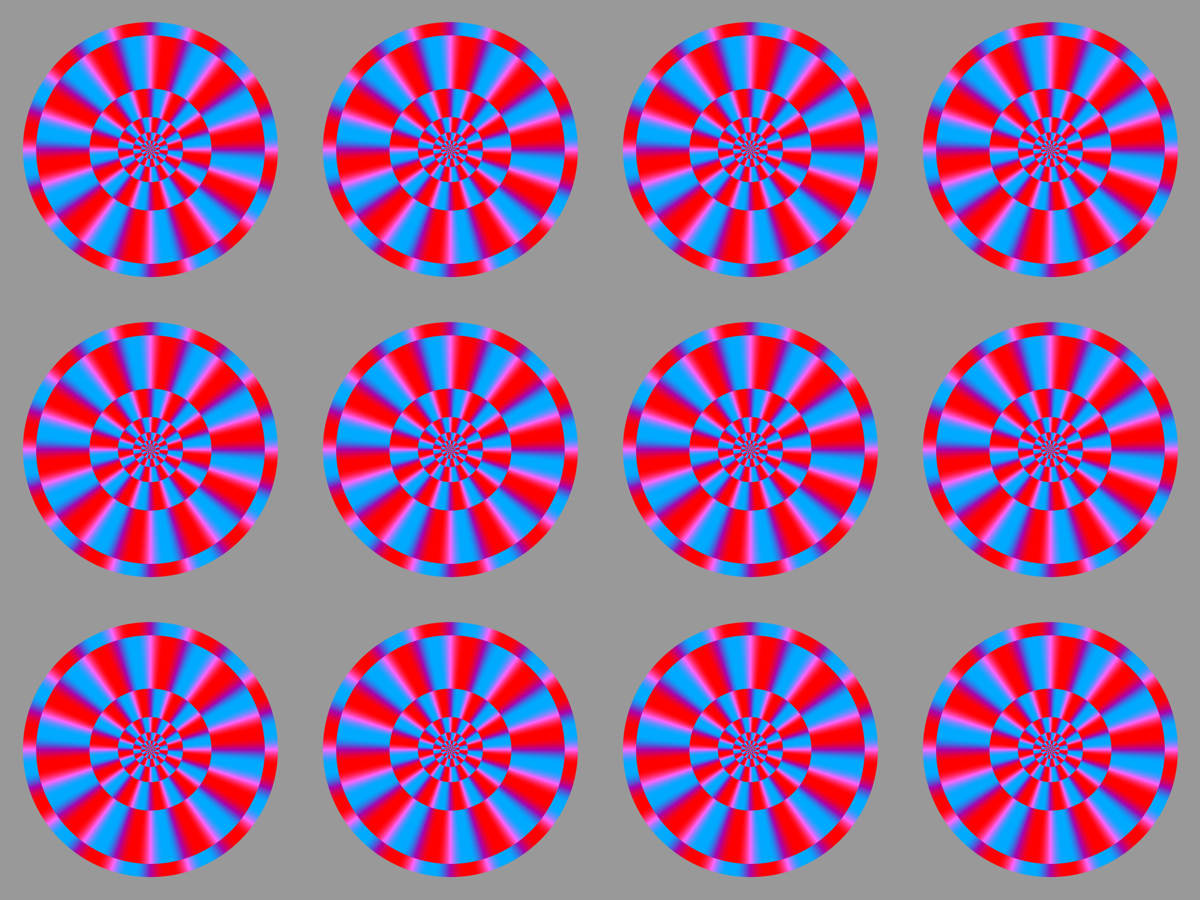
"Rotating red-and-cyan disks 2"
Each disk appears to rotate clockwise on a bright display, while it appears to rotate counterclockwise with a printed image under dark illumination.
Copyright Akiyoshi Kitaoka 2013 (February 6)
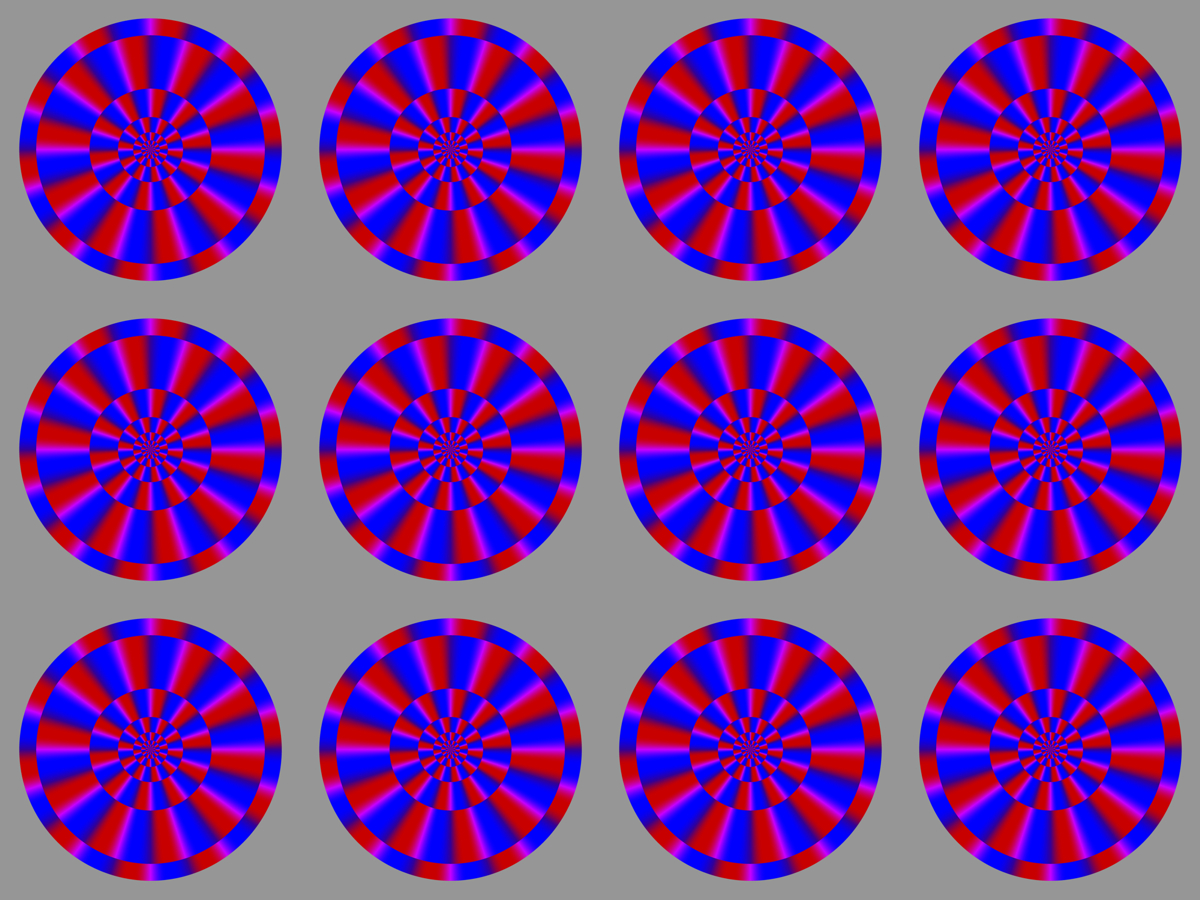
"Rotating red-and-blue disks"
Each disk appears to rotate clockwise on a bright display, while it appears to rotate counterclockwise with a printed image under dark illumination.
Copyright Akiyoshi Kitaoka 2013 (January 29)
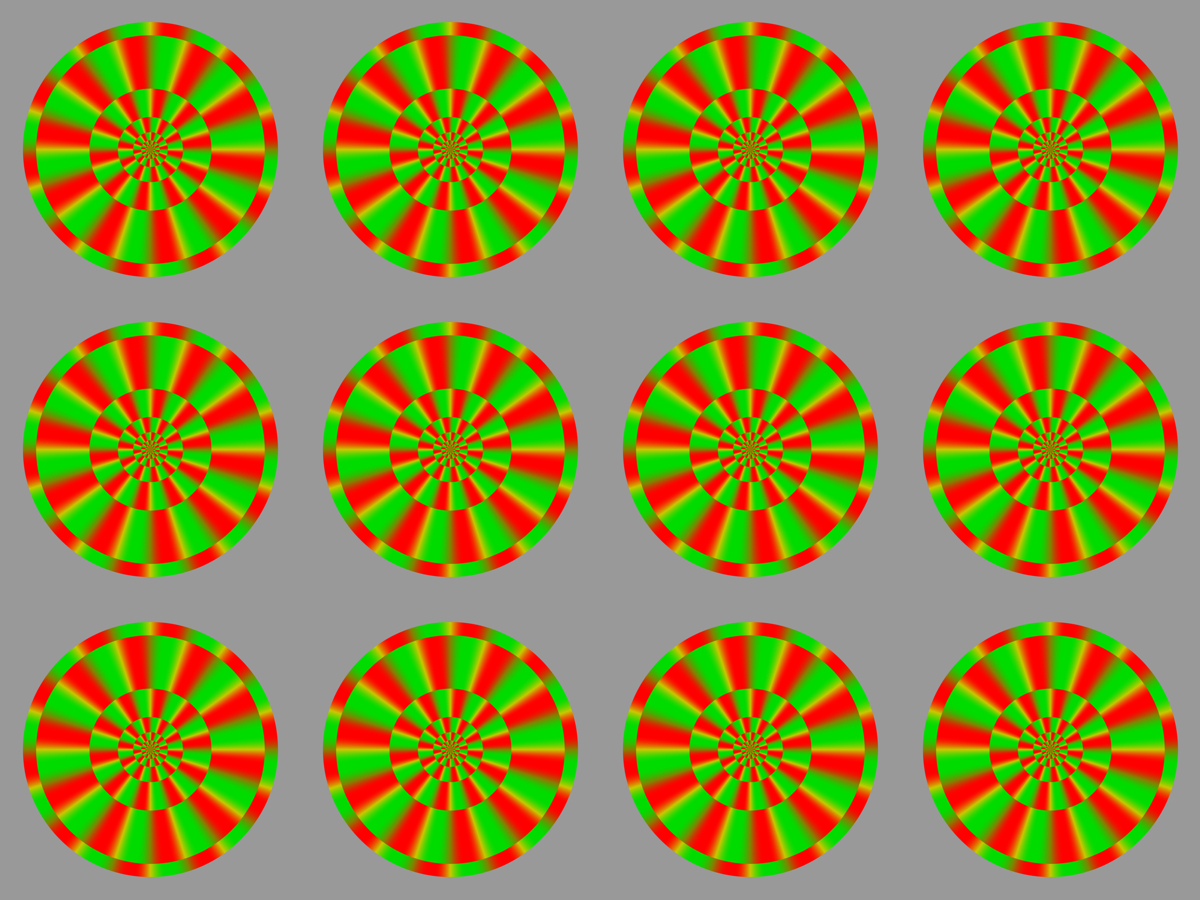
"Rotating red-and-green disks"
Each disk appears to rotate clockwise on a bright display, while it appears to rotate counterclockwise with a printed image under dark illumination.
Copyright Akiyoshi Kitaoka 2013 (January 29)
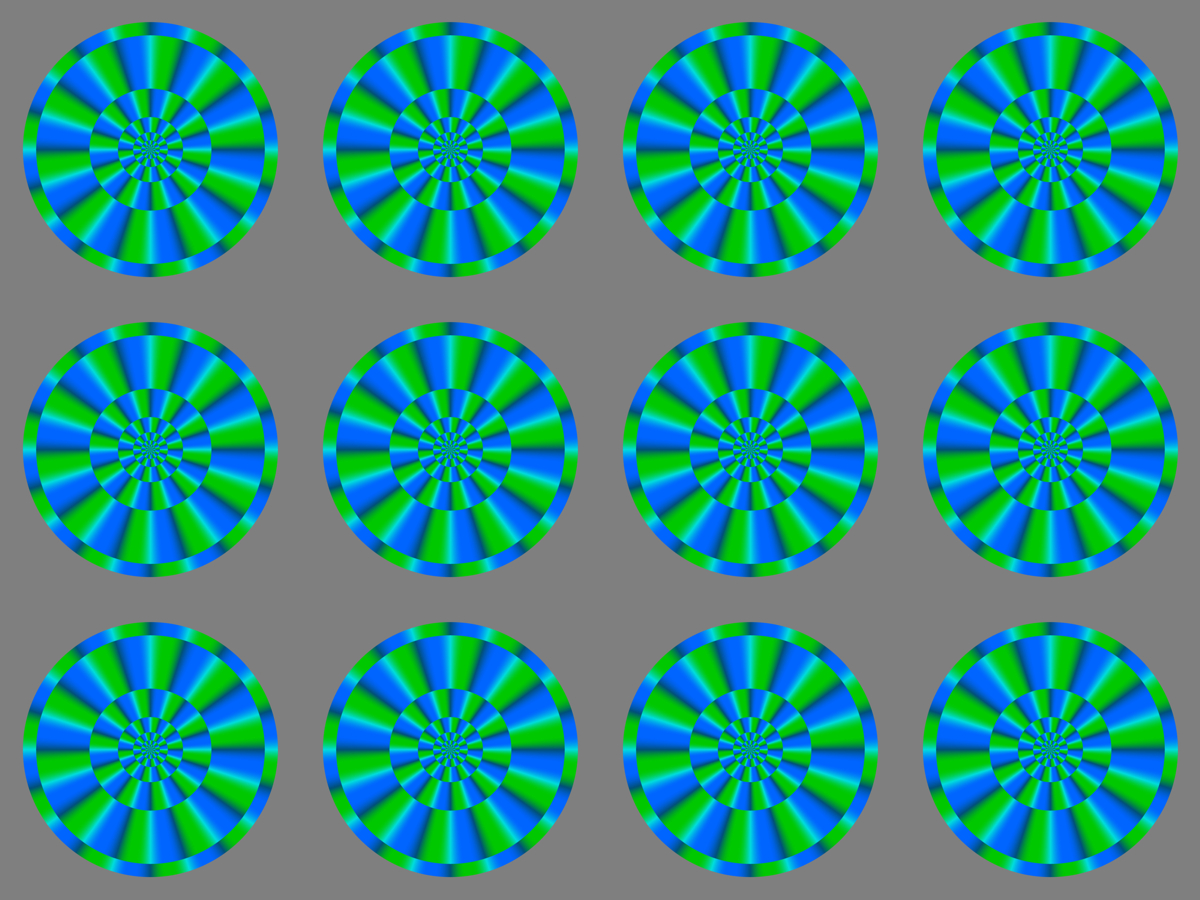
"Rotating blue-and-green disks"
Each disk appears to rotate clockwise on a bright display, while it slightly appears to rotate counterclockwise with a printed image under dark illumination.
Copyright Akiyoshi Kitaoka 2013 (February 6)
"Rotating gray-scale disks (movie)"
Disks appear to rotate clockwise or counterclockwise.
Copyright Akiyoshi Kitaoka 2013 (February 15)
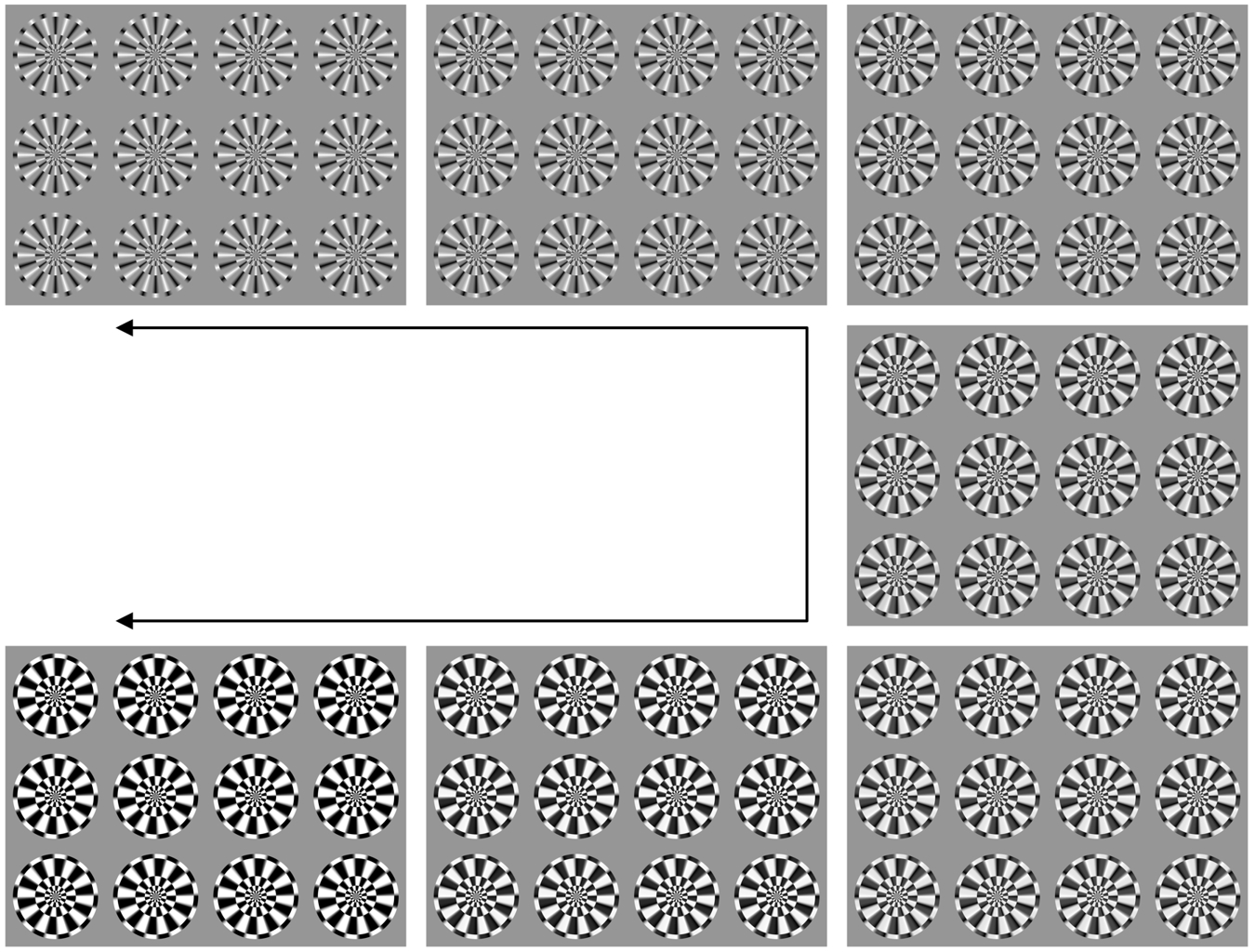
References
Anstis S M, 1970 “Phi movement as a subtraction process” Vision Research 10 1411-1430
Anstis S M, Rogers B J, 1975 “Illusory reversal of visual depth and movement during changes of contrast” Vision Research 15 957-961
Gregory R L, Heard P F, 1983 “Visual dissociations of movement, position, and stereo depth: some phenomenal phenomena” Quarterly Journal of Experimental Psychology 35A 217-237
Kitaoka, A. (2006). Configurational coincidence among six phenomena: A comment on van Lier and Csathó (2006). Perception, 35, 799-806. animations
"Rotating gray-scale disks 2 (movie)"
Disks appear to rotate clockwise.
Copyright Akiyoshi Kitaoka 2013 (February 15)
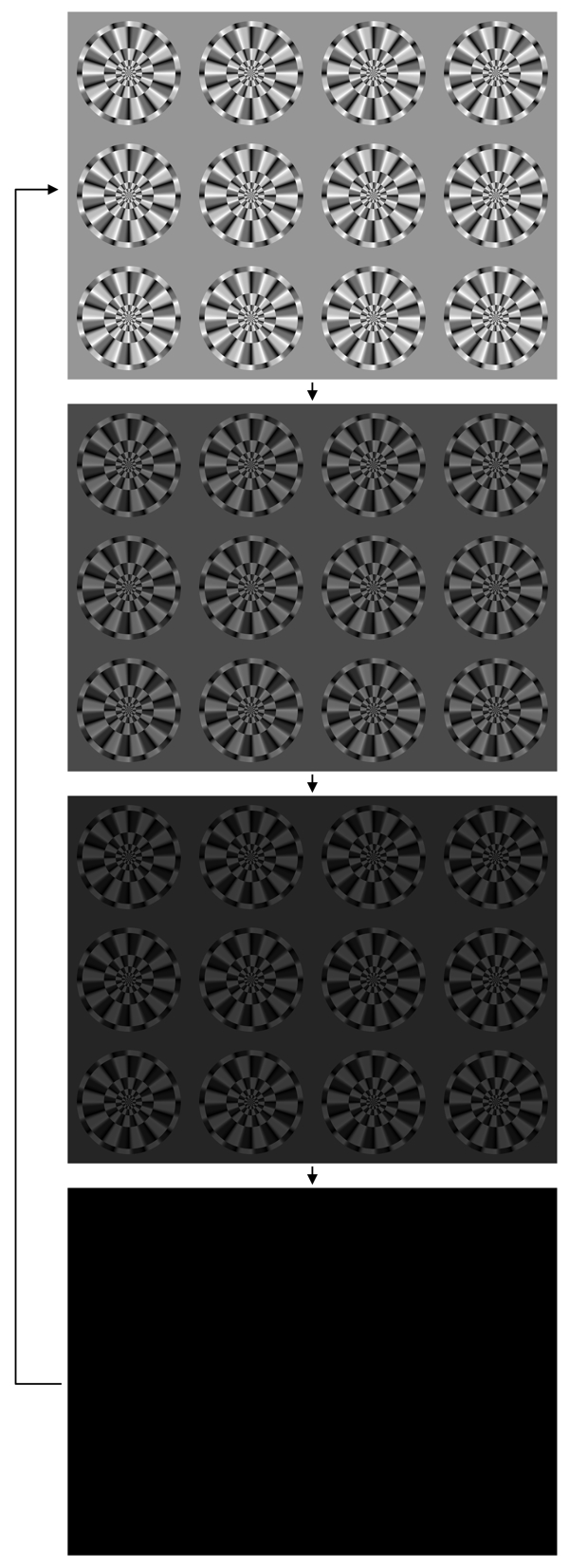
Kitaoka, A. (2006) Configurational coincidence among six phenomena: A comment on van Lier and Csathó (2006). Perception, 35, 799-806. PDF
Configurational coincidence among six phenomena: A comment to van Lier
and Csathó (2005)
Akiyoshi Kitaoka
Department of Psychology, Ritsumeikan University, Kyoto 603-8577, Japan
E-mail: akitaoka@lt.ritsumei.ac.jp
Macromedia Flash Player is necessary to play animations on this page.
Animation 1
Reversed phi movement (Anstis and Rogers 1975). There are four rectangles, each of which is flanked by thin lines that are dark or light. When the luminance of the rectangles decreases and that of the background increases accordingly, the upper two appear to converge in motion while the lower two appear to go apart in motion. On the other hand, when the luminance of the rectangles increases and that of the background decreases accordingly, the upper two appear to go apart in motion while the lower two appear to approach each other in motion. In sum, the direction of apparent motion is from the dark flank to the neighboring part that goes darkening or from the light flank to the neighboring part that goes brightening. Although the rectangles are aligned vertically, the apparent positional displacement occurs in the opposite direction to motion. If observers cross-fuse (uncross-fuse) the right and left rectangles, the upper rectangle appears to be in front of (behind) the lower one when they are dark.
Animation 2
The illusory motion investigated by Gregory and Heard (1983). This appearance is quite similar to Animation 1. The only configurational difference from the reversed phi movement is that the luminance of the rectangles is constant.
Animation 3
The illusory motion mentioned by Gregory and Heard (1983), in which the luminance of the rectangles dynamically changes while that of the surround is constant. This appearance is quite similar to Animations 1 and 2.
Animation 4
Phi movement (Anstis and Rogers 1975). For panel (a), dark stationary rectangles are placed on a bright stationary background. When the luminance of the right flank of each rectangle increases and that of the left flank decreases, the rectangle appears to shift leftward in motion as well as in position. Conversely, the luminance of the right flank decreases and that of the left flank increases, the rectangle appears to shift rightward in motion and position. If observers cross-fuse (uncross-fuse) the right and left rectangles, the fused rectangle appears to be in front (behind) when the right flank of the right rectangle are dark and the left flank of the left rectangle are dark. For panel (b), bright rectangles are placed on a dark background. In this case, phenomena are the reversal of panel (a).
(a) (b)
(a) Flash(swf) --- QuickTime(mov)
(b) Flash(swf) --- QuickTime(mov)
Animation 5
Consistency between the reversed phi movement and stereopsis (Anstis and Rogers 1975). In this animation, there are two phases in motion, in which the upper-left and the lower-right rectangles are one eighth phase in advance of the upper-right and the lower-left rectangles. For example, when the luminance of the rectangles increases, the upper-left rectangle appear to go leftward followed by the upper-right one, while the lower-right rectangle appear to go leftward followed by the lower-left one. In this period, the cross-fused (uncross-fused) upper rectangle appears to be in front (behind) as compared with the cross-fused (uncross-fused) lower rectangle.
Animation 6
Consistency between the apparent motion and Café-Wall-like tilt illusions (van Lier and Csathó 2005). According to dynamic changes in luminance gradient, the flanks of the rectangle appears to tilt dynamically. (a) The luminance gradient given to both flanks is dynamically changed while the dark-gray rectangle and the light-gray background are stationary. The dark part of the gradient appears to shift outward in motion and position while the bright part appears to shift inward in motion and position. This distortion agrees with the tilt illusion. (b) The luminance gradient given to the rectangle is dynamically changed while the dark flanks and the gray background are stationary. At the dark part of the gradient, the neighboring part of flanks appears to shift inward in motion and position, while at the bright part of the gradient, the neighboring part of flanks appears to shift outward in motion and position. This distortion agrees with the tilt illusion.
(a) (b)
(a) Flash(swf) --- QuickTime(mov)
(b) Flash(swf) --- QuickTime(mov)
Animation 7
Inconsistency between the apparent motion and Café-Wall-like tilt illusions. According to dynamic changes in homogenous areas, the flanks of the rectangle appears to tilt dynamically. (a) The luminance of the homogeneous rectangle is dynamically changed while the flanks with luminance gradient and the gray background are stationary. The darkening rectangle appears to attract the dark parts of the flanks inward in motion while the brightening rectangles appears to attract the light parts of the flanks inward in motion. This distortion disagrees with the tilt illusion. (b) The luminance of the homogeneous flanks is dynamically changed while the rectangle with luminance gradient and the gray background are stationary. At the dark part of the gradient, brightening flanks appears to shift inward in motion, while at the bright part of the gradient, darkening flanks appears to shift inward in motion. This distortion disagrees with the tilt illusion
(a) (b)
(a) Flash(swf) --- QuickTime(mov)
(b) Flash(swf) --- QuickTime(mov)
Animation 8
Demonstration of the apparent motion in the three elemental spatio-temporal configurations (Figure 6). The behaviors in (a), (b) and (g) are summarized in Figure 6a (off-center line-type configuration); those in (c), (d) and (h) are in Figure 6b (on-center line-type configuration); and those in (e), (f) and (i) are summarized in Figure 6c (edge-type configuration). For further explanations, see the text.
(a) (b)
(a) Flash(swf) --- Quicklime(mov)
(b) Flash(swf) --- QuickTime(mov)
(c) (d)
(c) Flash(swf) --- QuickTime(mov)
(d) Flash(swf) --- QuickTime(mov)
(e) (f)
(e) Flash(swf) --- QuickTime(mov)
(f) Flash(swf) --- QuickTime(mov)
(g) (h) (i)
(g) Flash(swf) --- QuickTime(mov)
(h) Flash(swf) --- QuickTime(mov)
(i) Flash(swf) --- QuickTime(mov)
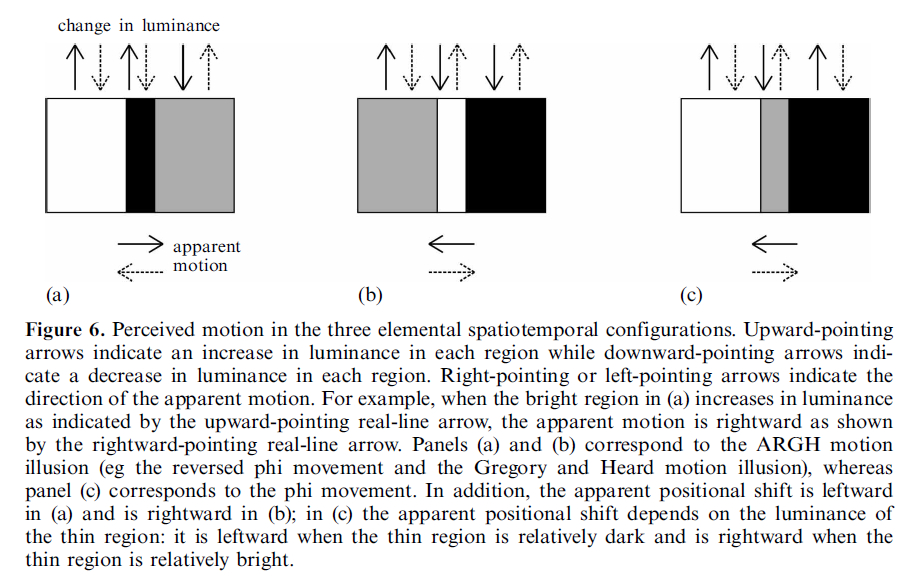
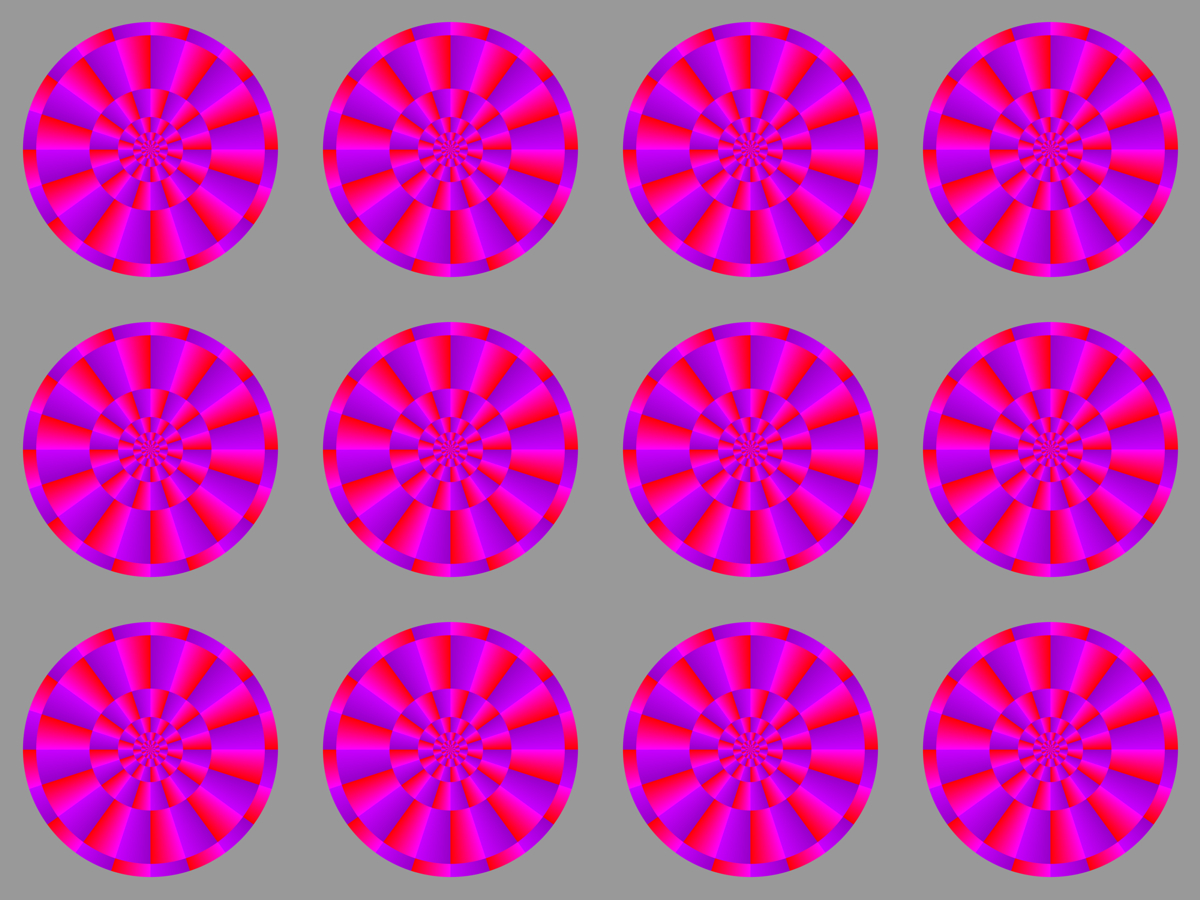
「赤と紫の円盤の回転・OFWタイプI」
明るいディスプレーでは円盤は時計回りに回転して見える。印刷物を暗いところで見ると反時計回りに回転して見える。
Copyright Akiyoshi Kitaoka 2013 (February 18)
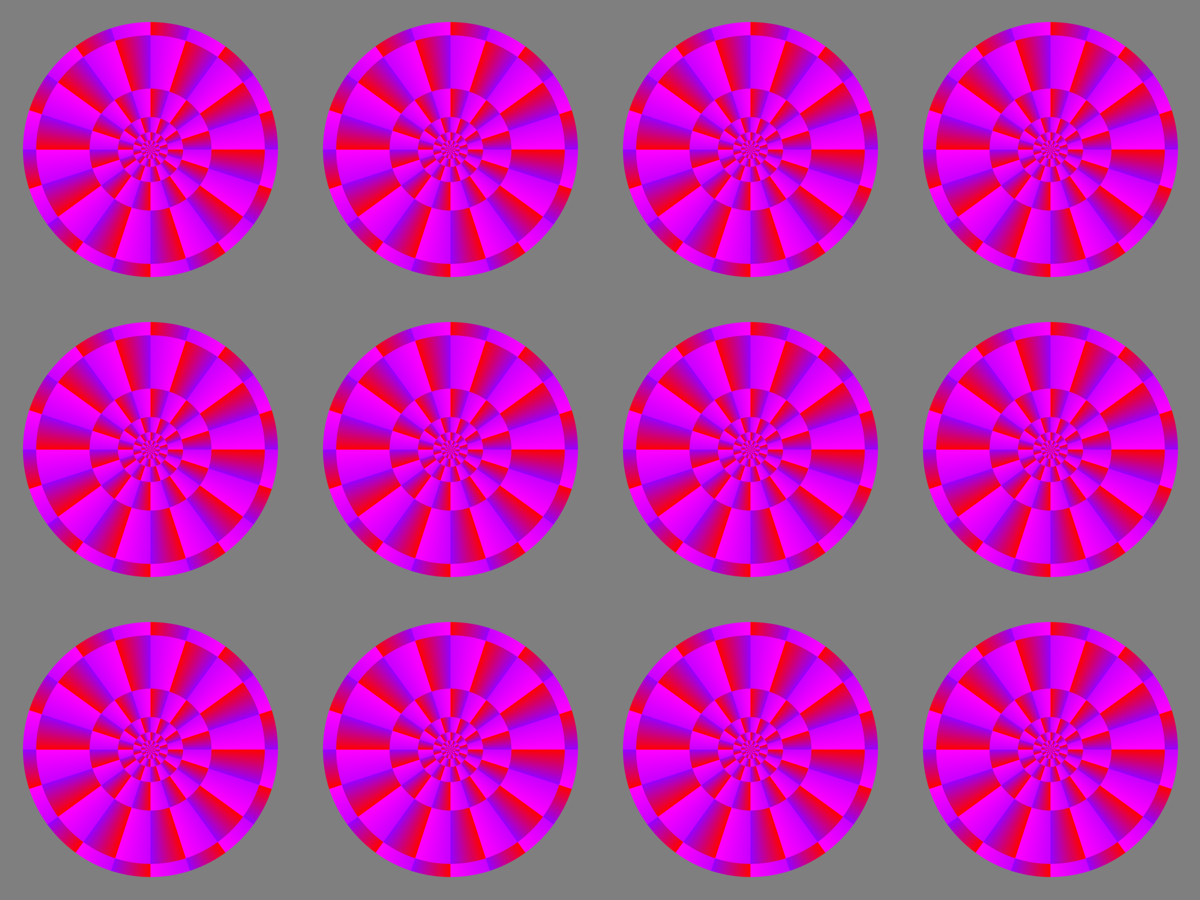
「赤と紫の円盤の回転・OFWタイプI・その2」
明るいディスプレーでは円盤は時計回りに回転して見える。印刷物を暗いところで見ると反時計回りに回転して見える。
Copyright Akiyoshi Kitaoka 2013 (February 18)
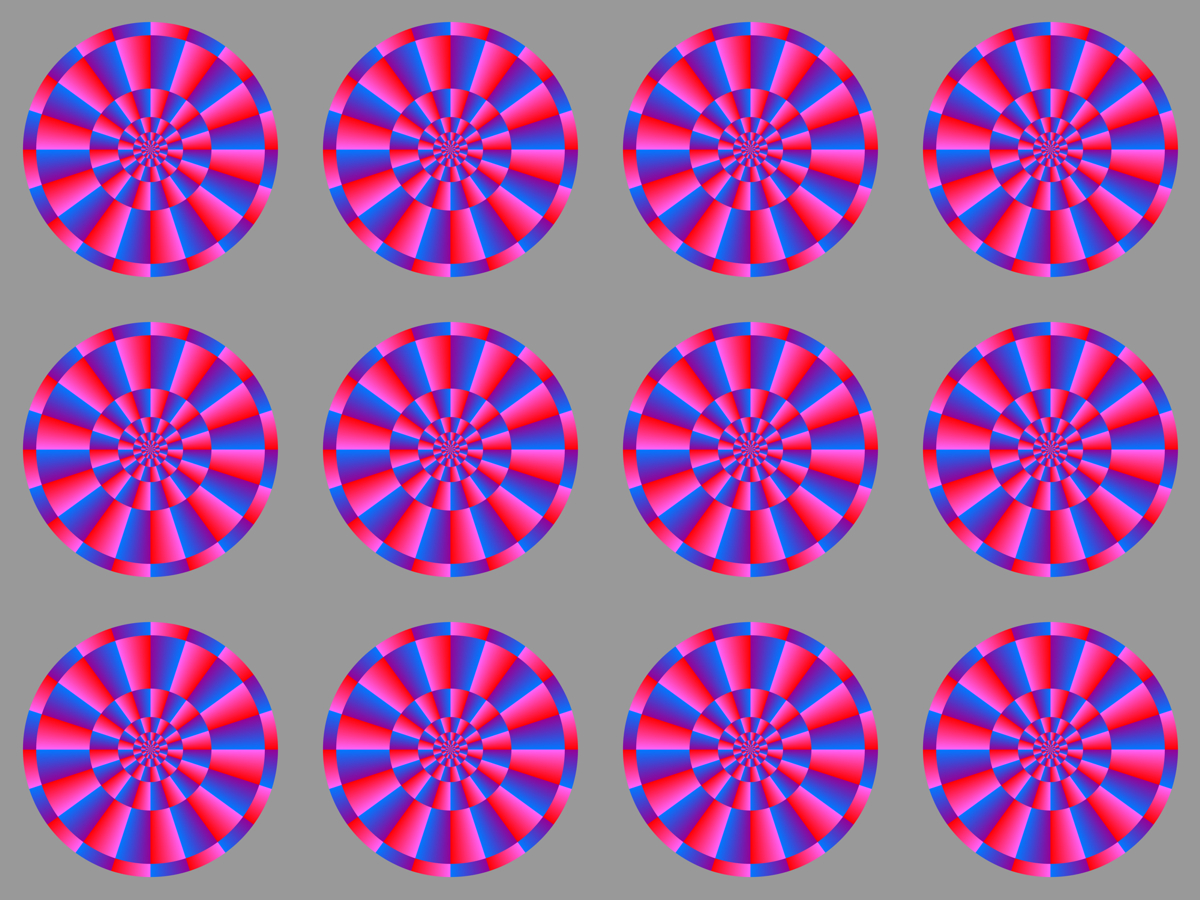
「赤とシアンの円盤の回転・OFWタイプI」
明るいディスプレーでは円盤は時計回りに回転して見える。印刷物を暗いところで見ると反時計回りに回転して見える。
Copyright Akiyoshi Kitaoka 2013 (February 18)
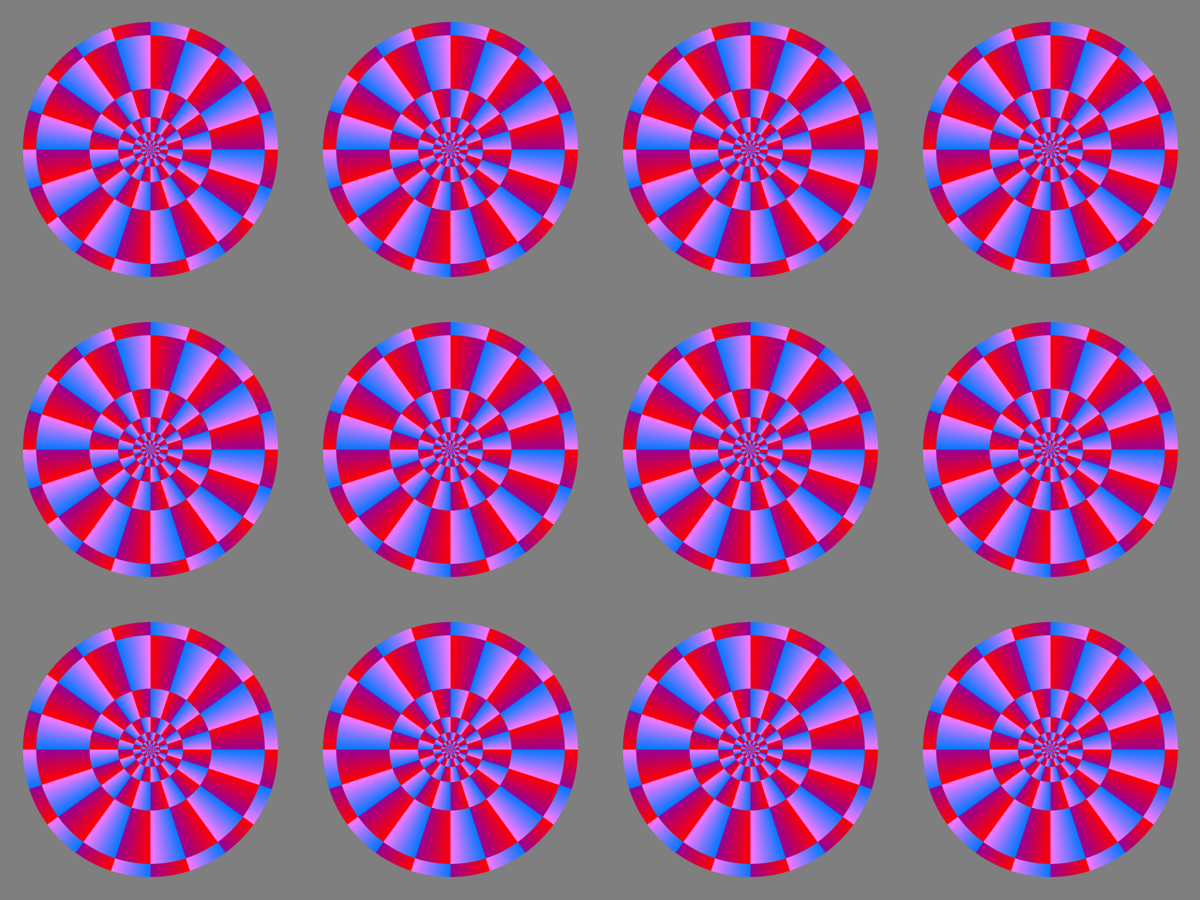
「赤とシアンの円盤の回転・OFWタイプI・その2」
明るいディスプレーでは円盤は時計回りに回転して見える。印刷物を暗いところで見ると反時計回りに回転して見える。
Copyright Akiyoshi Kitaoka 2013 (February 18)

「赤と緑の円盤の回転・OFWタイプI」
明るいディスプレーでは円盤は時計回りに回転したり、反時計回りに戻ったりするように見える。印刷物を暗いところで見ると反時計回りに回転して見える。
Copyright Akiyoshi Kitaoka 2013 (February 18)
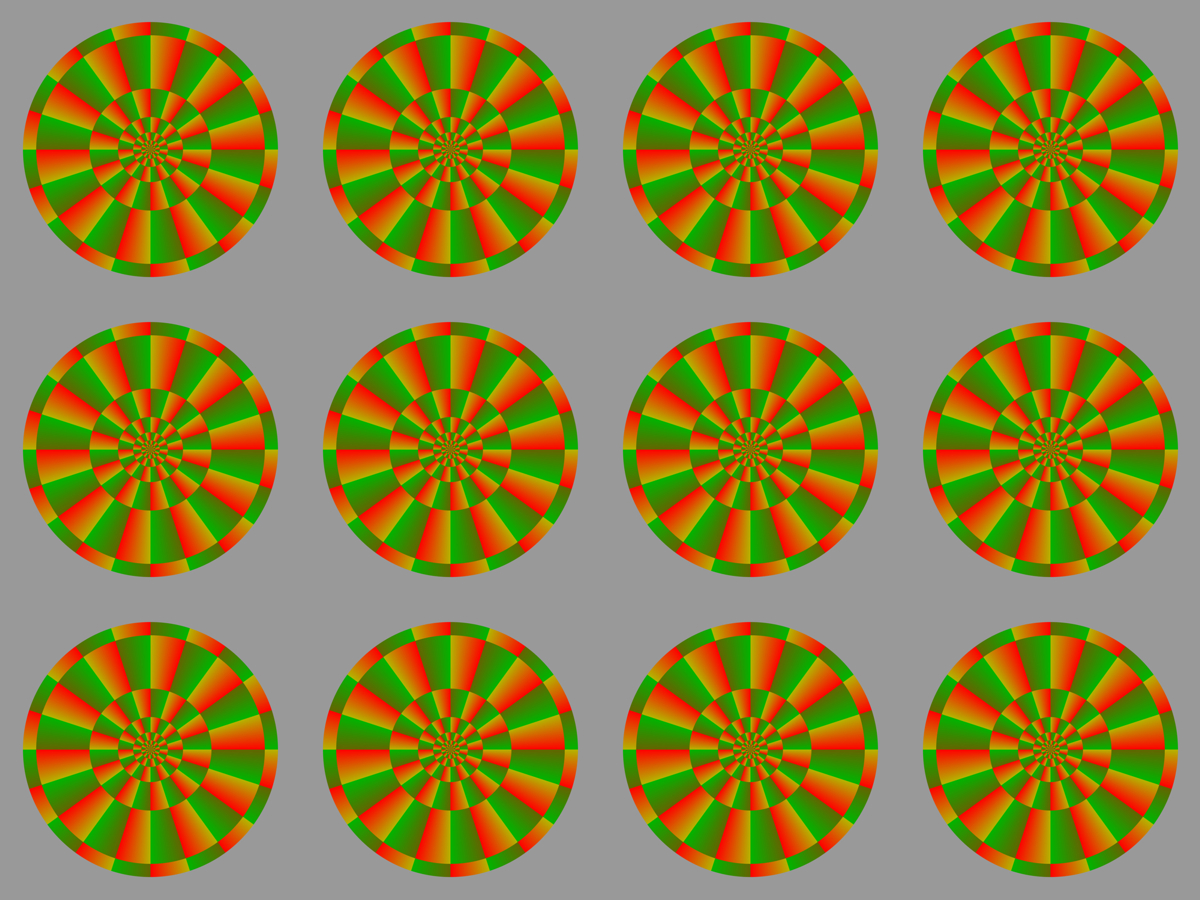
「赤と緑の円盤の回転・OFWタイプI・その2」
明るいディスプレーでは円盤は時計回りに回転するように見える。印刷物を暗いところで見ると反時計回りに回転して見える。
Copyright Akiyoshi Kitaoka 2013 (February 18)

「赤と紫の円盤の回転・OFWタイプIIa」
明るいディスプレーでは円盤は時計回りに回転して見える。印刷物を暗いところで見ると反時計回りに回転して見える。
Copyright Akiyoshi Kitaoka 2013 (February 18)
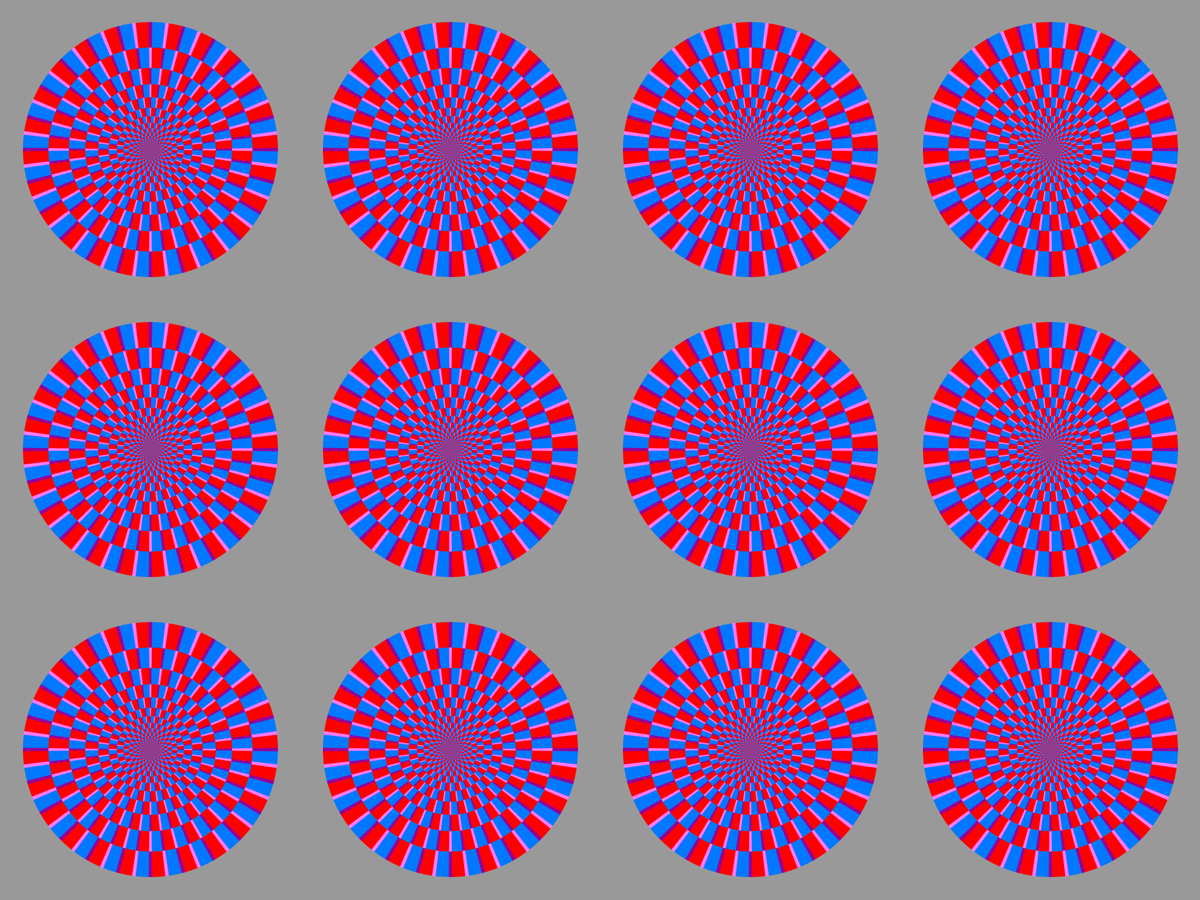
「赤とシアンの円盤の回転・OFWタイプIIa」
明るいディスプレーでは円盤は時計回りに回転して見える。印刷物を暗いところで見ると反時計回りに回転して見える。
Copyright Akiyoshi Kitaoka 2013 (February 18)
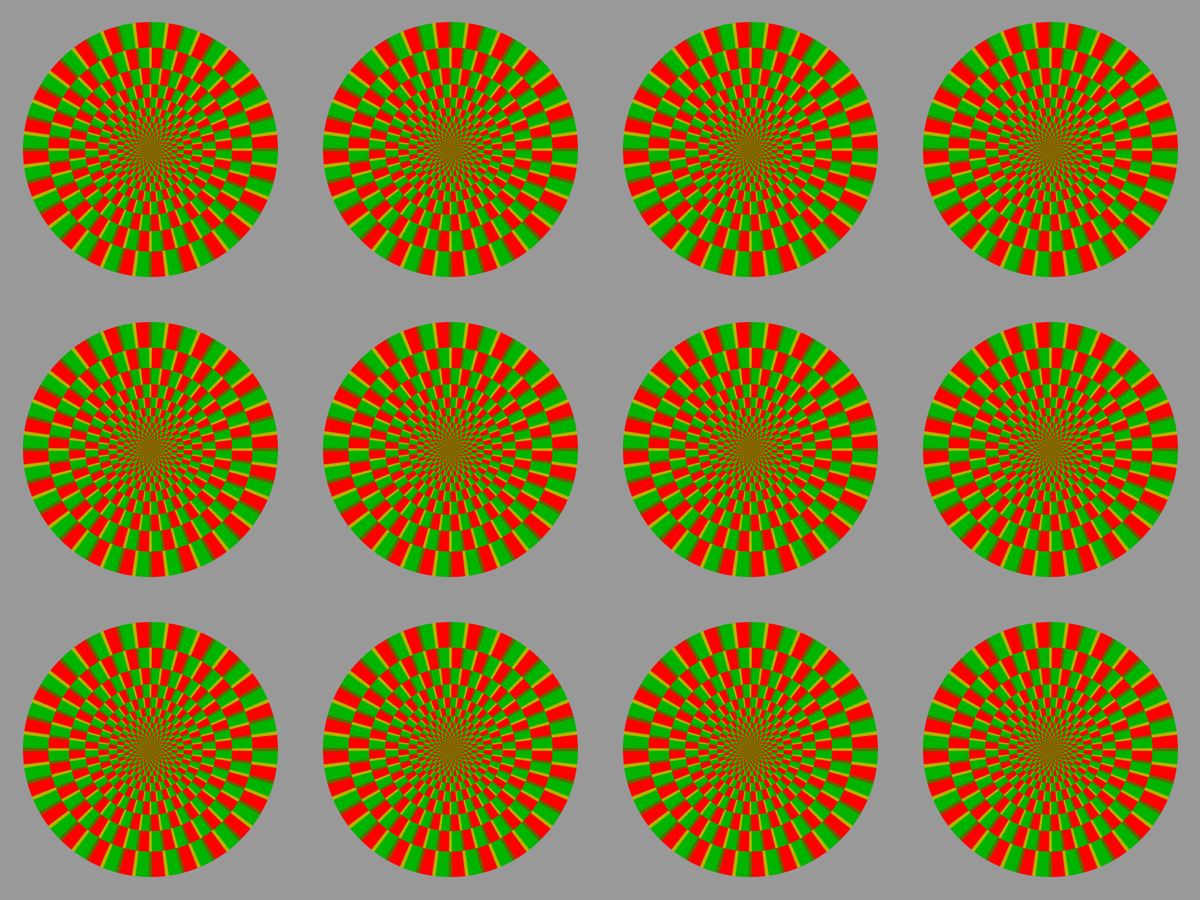
「赤と緑の円盤の回転・OFWタイプIIa」
明るいディスプレーでは円盤は時計回りに回転して見える。印刷物を暗いところで見ると反時計回りに回転して見える。
Copyright Akiyoshi Kitaoka 2013 (February 18)
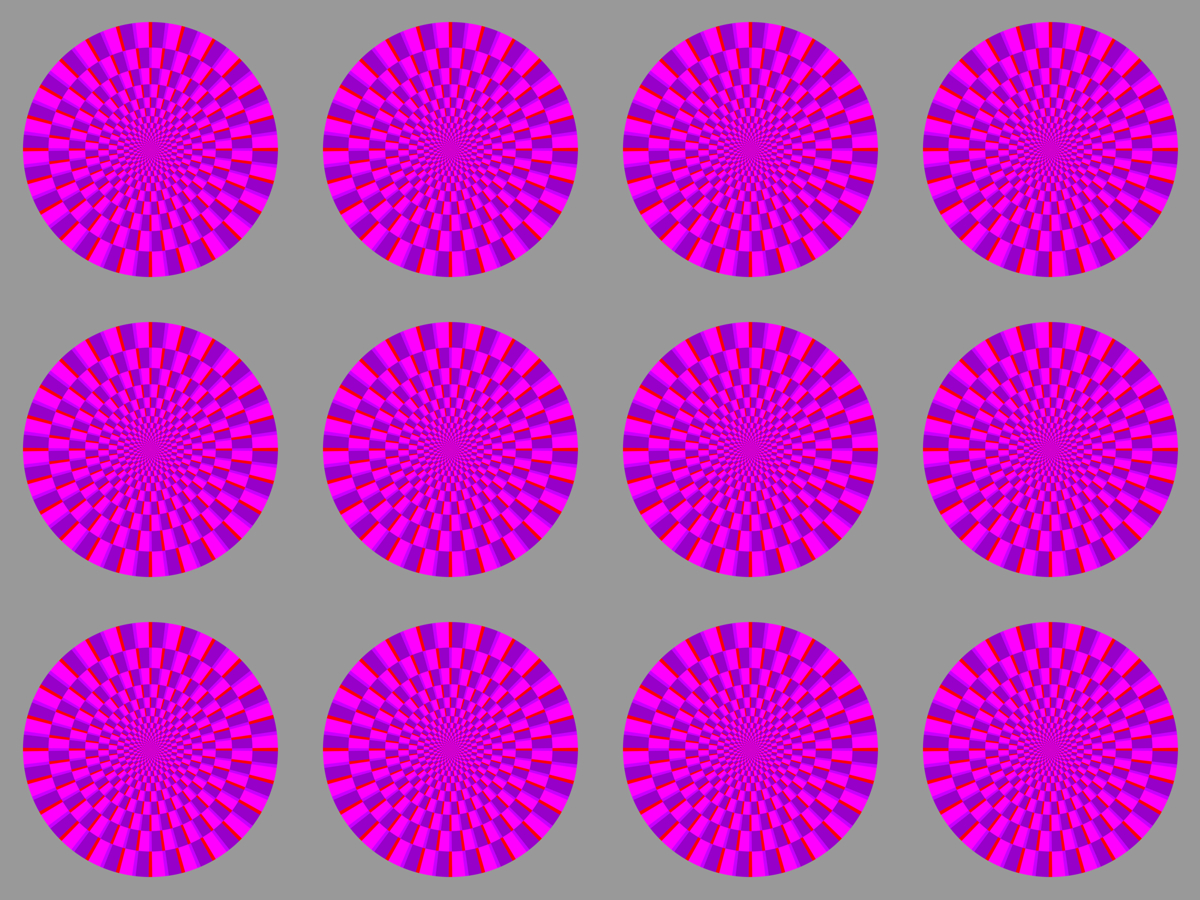
「赤と紫の円盤の回転・OFWタイプIIb」
明るいディスプレーでは円盤は時計回りに回転して見える。印刷物を暗いところで見ると反時計回りに回転して見える(弱いが)。
Copyright Akiyoshi Kitaoka 2013 (February 18)

「赤とシアンの円盤の回転・OFWタイプIIb」
明るいディスプレーでは円盤は時計回りに回転して見える。印刷物を暗いところで見ると反時計回りに回転して見える(弱いが)。
Copyright Akiyoshi Kitaoka 2013 (February 18)
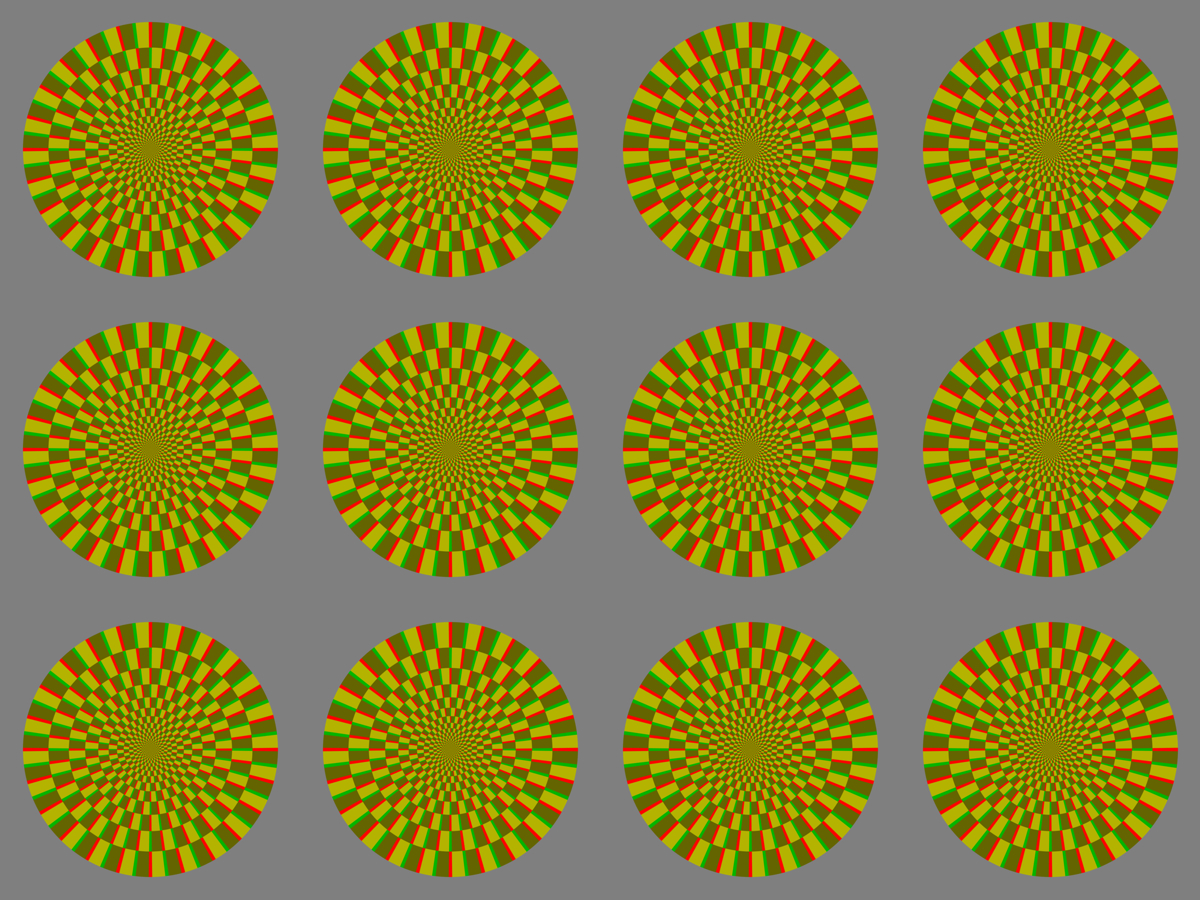
「赤と緑の円盤の回転・OFWタイプIIb」
明るいディスプレーでは円盤は時計回りに回転して見える。印刷物を暗いところで見ると反時計回りに回転して見える(弱いが)。
Copyright Akiyoshi Kitaoka 2013 (February 18)
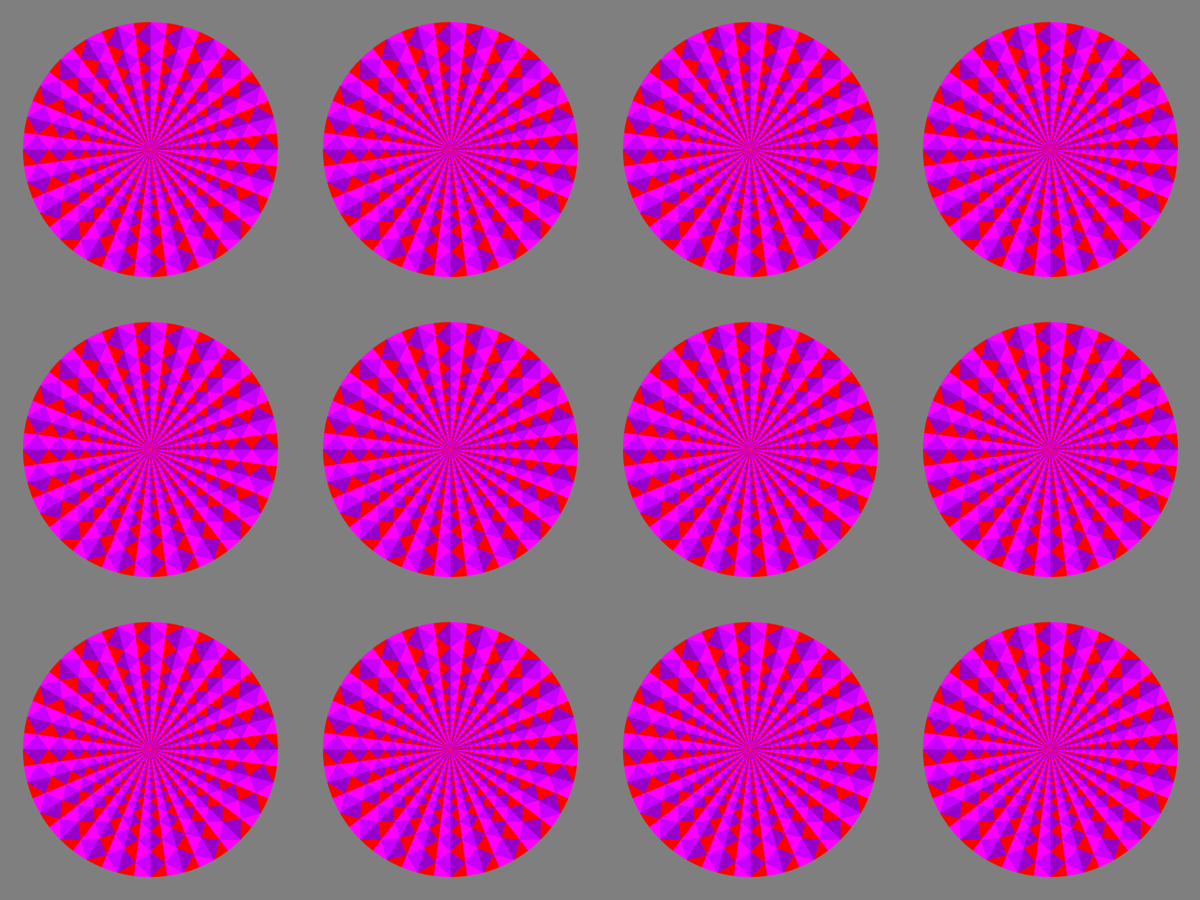
「赤と紫の円盤の回転・OFWタイプIII」
明るいディスプレーでは円盤は時計回りに回転して見える。印刷物を暗いところで見ると反時計回りに回転して見える(弱いが)。
Copyright Akiyoshi Kitaoka 2013 (February 18)

「赤と紫の円盤の回転・OFWタイプIII・その2」
明るいディスプレーでは円盤は時計回りに回転して見える。印刷物を暗いところで見ると反時計回りに回転して見える(弱いが)。
Copyright Akiyoshi Kitaoka 2013 (February 18)
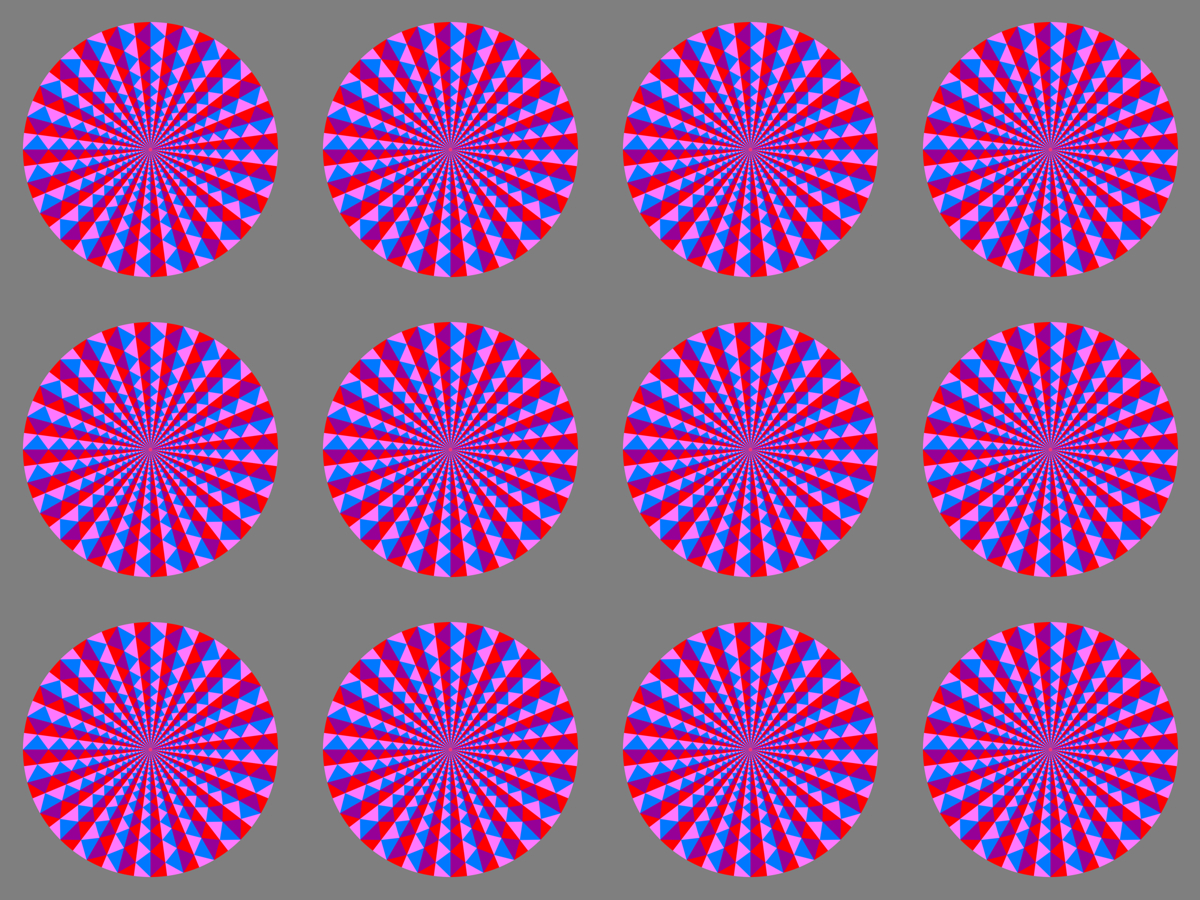
「赤とシアンの円盤の回転・OFWタイプIII」
明るいディスプレーでは円盤は時計回りに回転して見える。印刷物を暗いところで見ると反時計回りに回転して見える(弱いが)。
Copyright Akiyoshi Kitaoka 2013 (February 18)
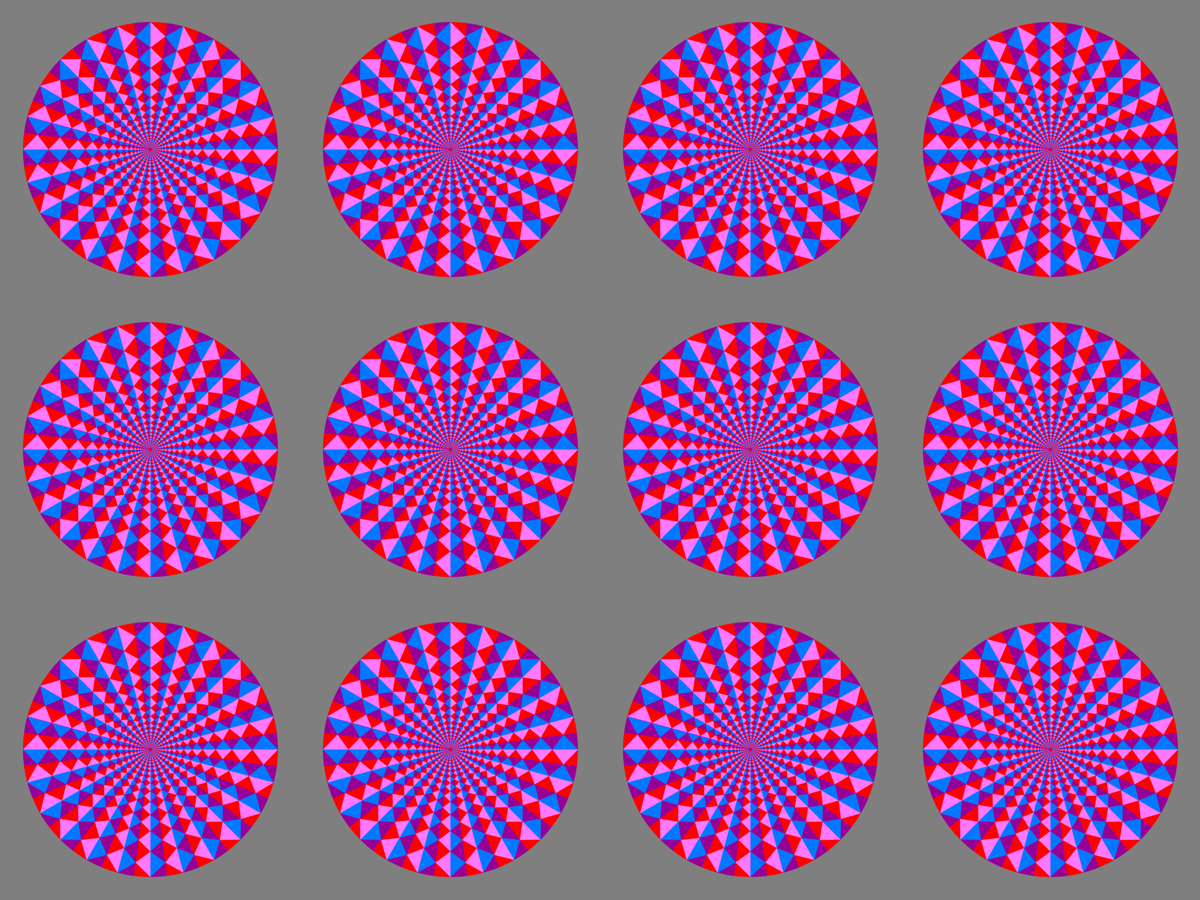
「赤とシアンの円盤の回転・OFWタイプIII・その2」
明るいディスプレーでは円盤は時計回りに回転して見える。印刷物を暗いところで見ると反時計回りに回転して見える(弱いが)。
Copyright Akiyoshi Kitaoka 2013 (February 18)
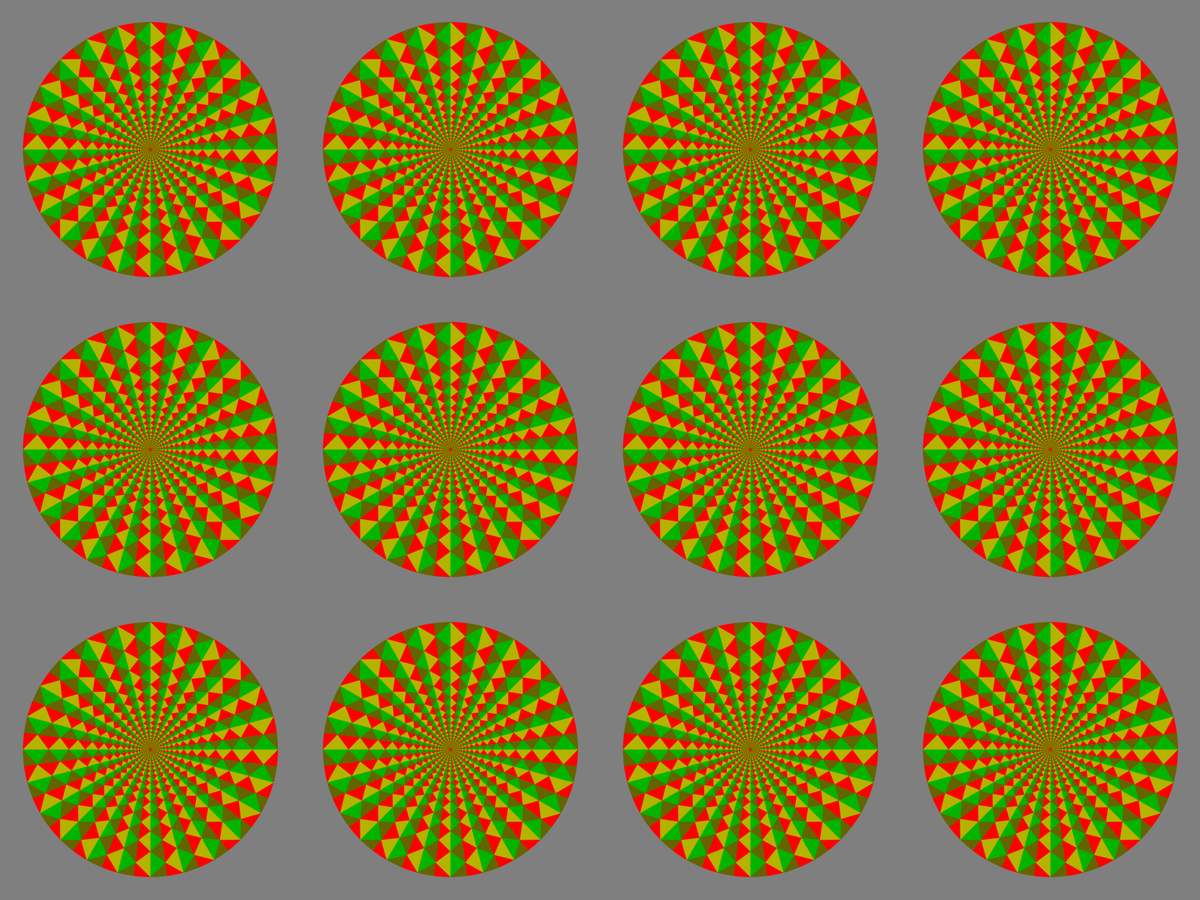
「赤と緑の円盤の回転・OFWタイプIII・その2」
明るいディスプレーでは円盤は時計回りに回転して見える(弱いが)。印刷物を暗いところで見ると反時計回りに回転して見える(弱いが)。
Copyright Akiyoshi Kitaoka 2013 (February 18)
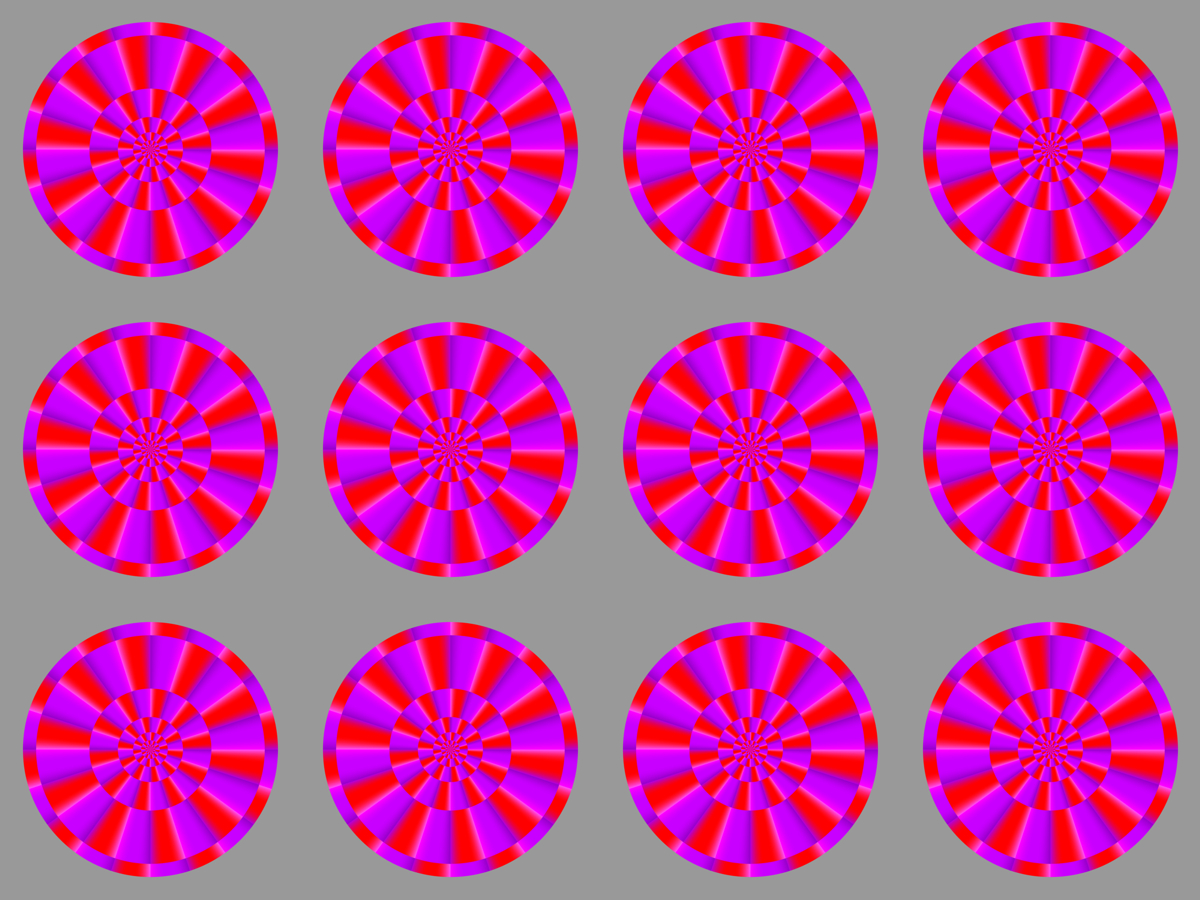
「赤と紫の円盤の回転・OFWタイプIV」
明るいディスプレーでは円盤は時計回りに回転して見える。印刷物を暗いところで見ると反時計回りに回転して見える。
Copyright Akiyoshi Kitaoka 2013 (February 18)
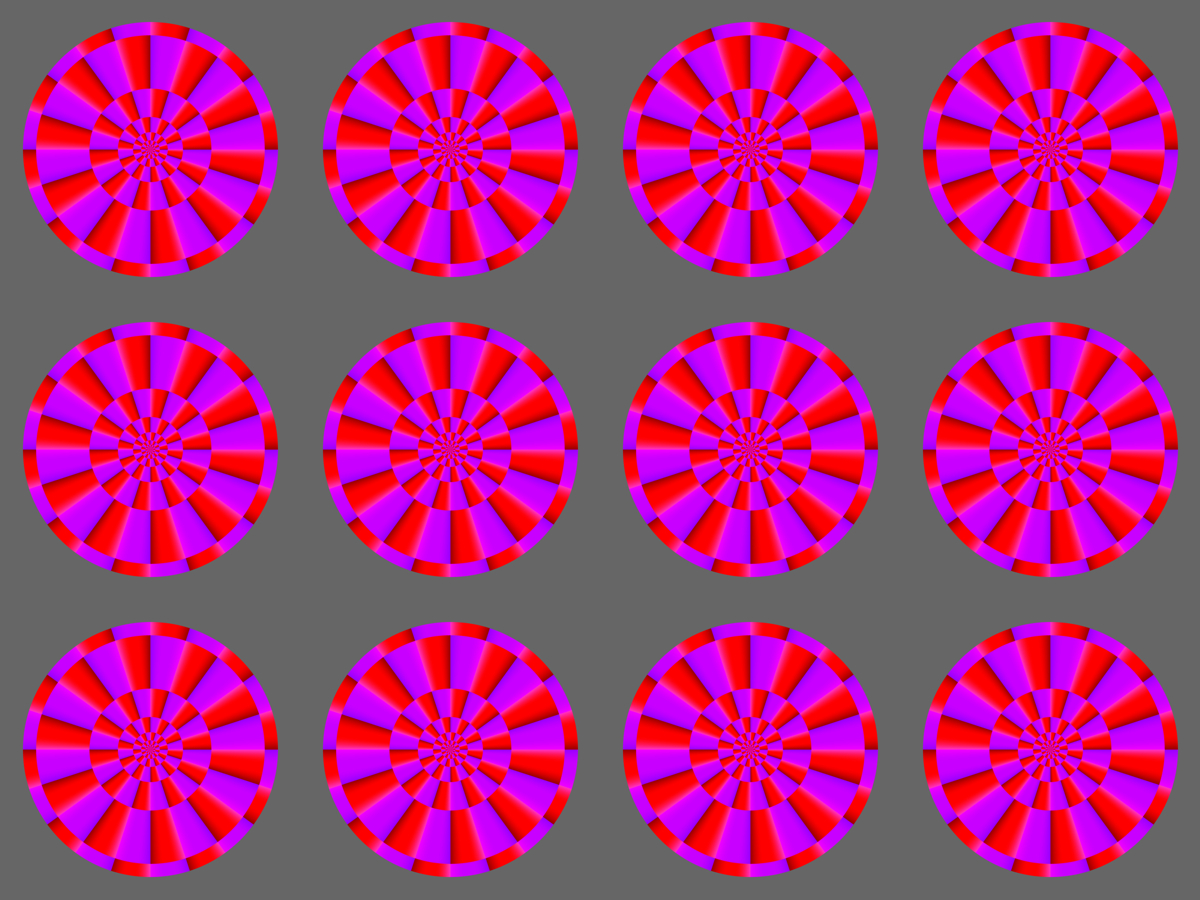
「赤と紫の円盤の回転・OFWタイプIV・その2」
明るいディスプレーでは円盤は時計回りに回転して見える。印刷物を暗いところで見ると反時計回りに回転して見える。
Copyright Akiyoshi Kitaoka 2013 (February 18)
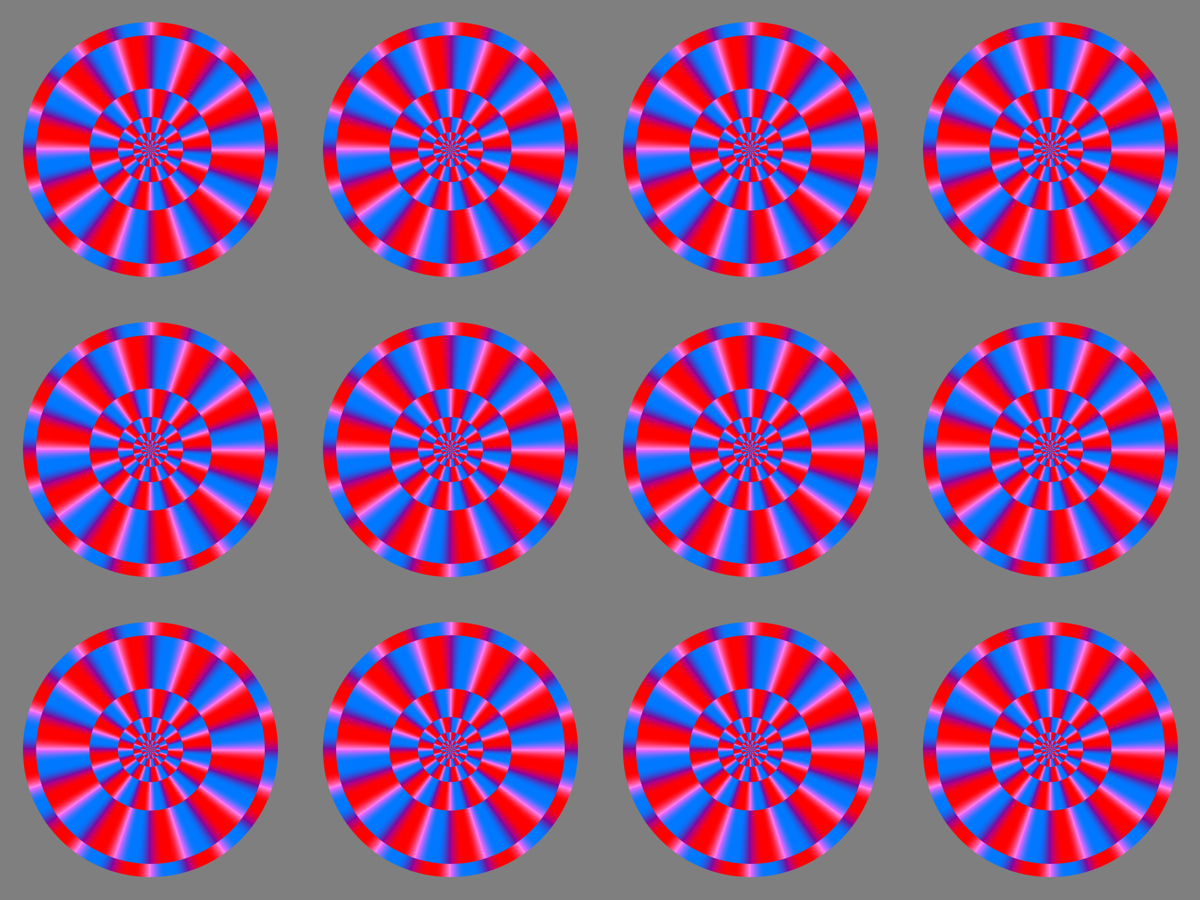
「赤とシアンの円盤の回転・OFWタイプIV」
明るいディスプレーでは円盤は時計回りに回転して見える。印刷物を暗いところで見ると反時計回りに回転して見える。
Copyright Akiyoshi Kitaoka 2013 (February 18)

「赤とシアンの円盤の回転・OFWタイプIV・その2」
明るいディスプレーでは円盤は時計回りに回転して見える。印刷物を暗いところで見ると反時計回りに回転して見える。
Copyright Akiyoshi Kitaoka 2013 (February 18)
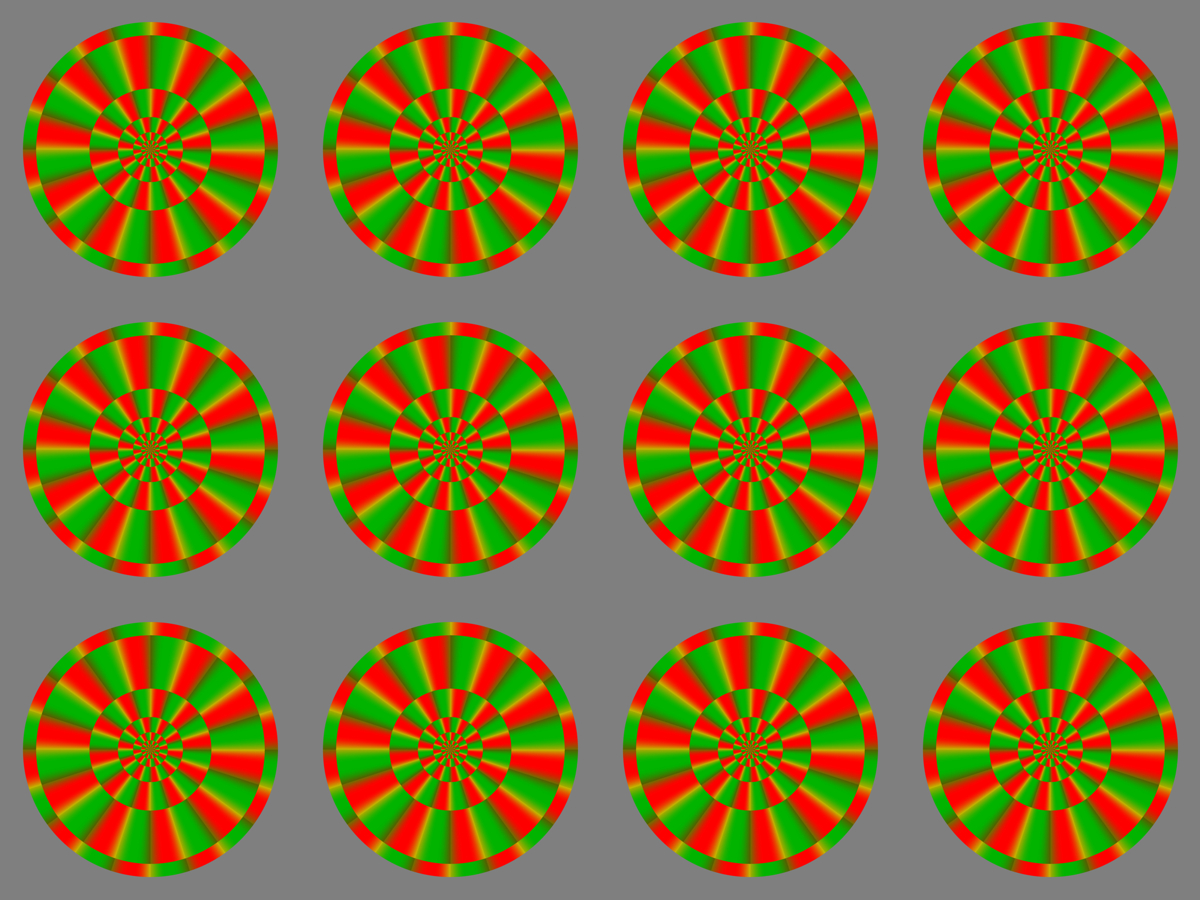
「赤と緑の円盤の回転・OFWタイプIV」
明るいディスプレーでは円盤は時計回りに回転したり、反時計回りに戻ったりするように見える。印刷物を暗いところで見ると反時計回りに回転して見える。
Copyright Akiyoshi Kitaoka 2013 (February 18)
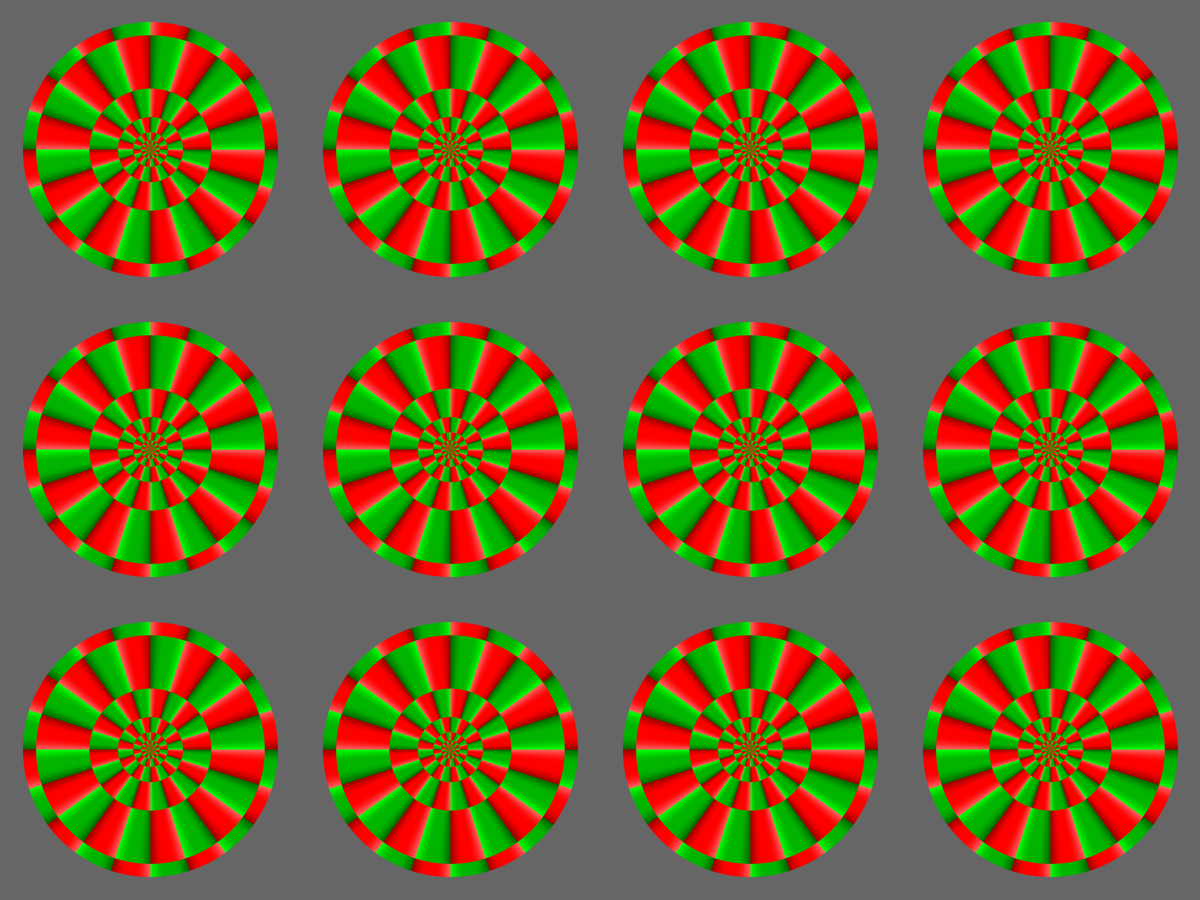
「赤と緑の円盤の回転・OFWタイプIV・その2」
明るいディスプレーでは円盤は時計回りに回転したり、反時計回りに戻ったりするように見える。印刷物を暗いところで見ると反時計回りに回転して見える。
Copyright Akiyoshi Kitaoka 2013 (February 18)
13. Kitaoka (2013, VSJ winter meeting)
explores this dimorphism comparing to related phenomena.
Flickering presentation of a particular order makes observers see illusory motion of two different directions.
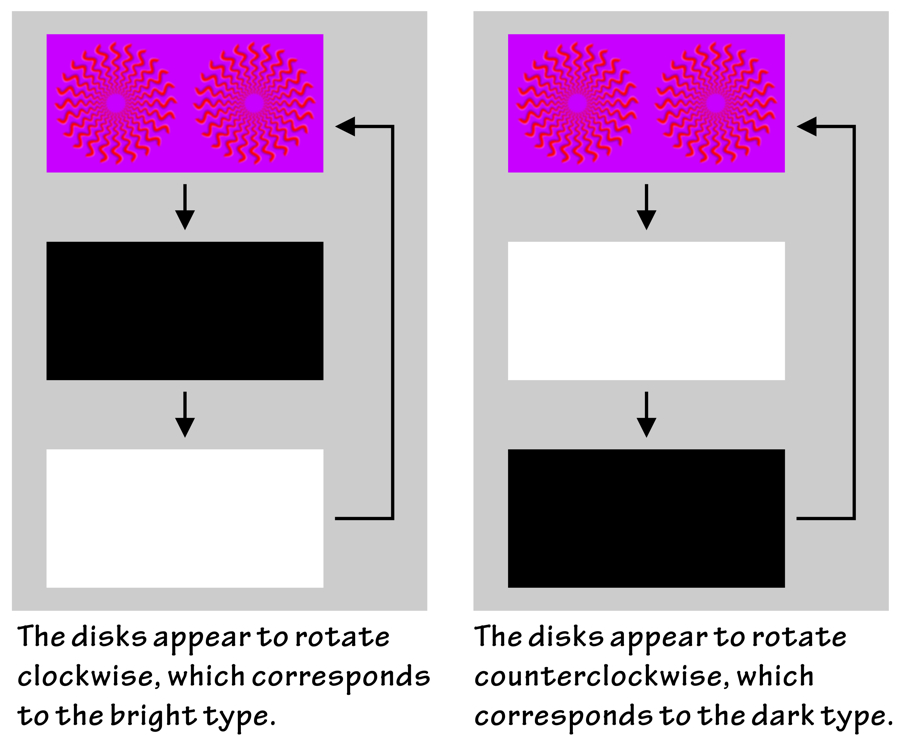
Warning: The movies shown below include flickering patterns. Please do not keep
watching them for a long time. Never copy them.
Target » black » white » target
Target » white » black » target
Cf. Flickering presentation of a Fraser-Wilcox figure also makes observers see illusory motion of two different directions.
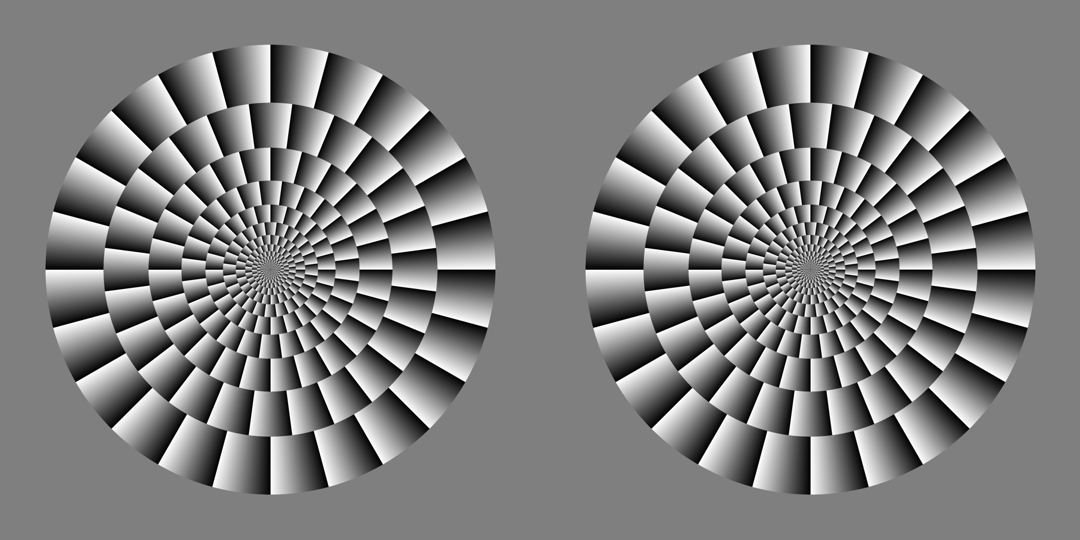
A Fraser-Wilcox figure, which makes some obersvers see clockwise rotation
while makes others see counterclockwise rotation.
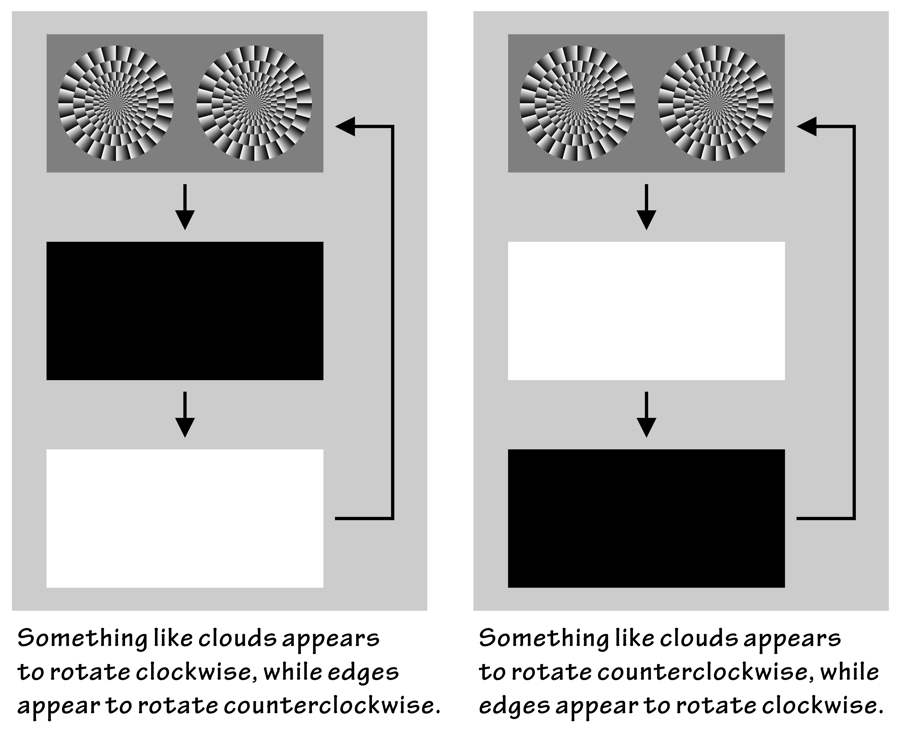
Warning: The movies shown below include flickering patterns. Please do not keep
watching them for a long time. Never copy them.
Target » black » white » target
Target » white » black » target
It is suggested that these dimorphisms might have something to do with
the subjective color phenomena such as the Behnham top because of the same
temporal arrangement of stimuli.
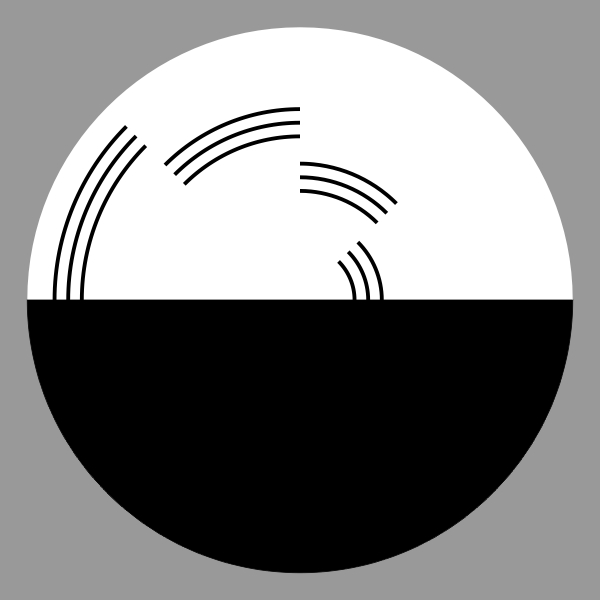
These observations might lead to clarification of motion perception, color mechanism, as well as the role of color in motion perception in the future.
14. Kitaoka (2013, recent study)
「水色が目立つ円盤の回転・動画」
ディスクが時計回りに回転して見える。
Copyright Akiyoshi Kitaoka 2013 (February 16)
「赤と紫の円盤の回転・動画」
円盤は時計回りに回転して見える。
Copyright Akiyoshi Kitaoka 2013 (February 16)
「赤とシアンの円盤の回転 2・動画」
円盤は時計回りに回転して見える。
Copyright Akiyoshi Kitaoka 2013 (February 16)
「赤とシアンの円盤の回転・動画」
円盤は時計回りに回転して見える。戻るようにも見える。
Copyright Akiyoshi Kitaoka 2013 (February 16)
「赤とシアンの円盤の往復回転」
円盤が消える時に反時計回り、現れる時に時計回りに回転して見える。
Copyright Akiyoshi Kitaoka 2013 (February 19)
黒背景と交替させると効果が弱い。特に、円盤が現れる時の回転錯視はほとんどない。
個々のフレーム
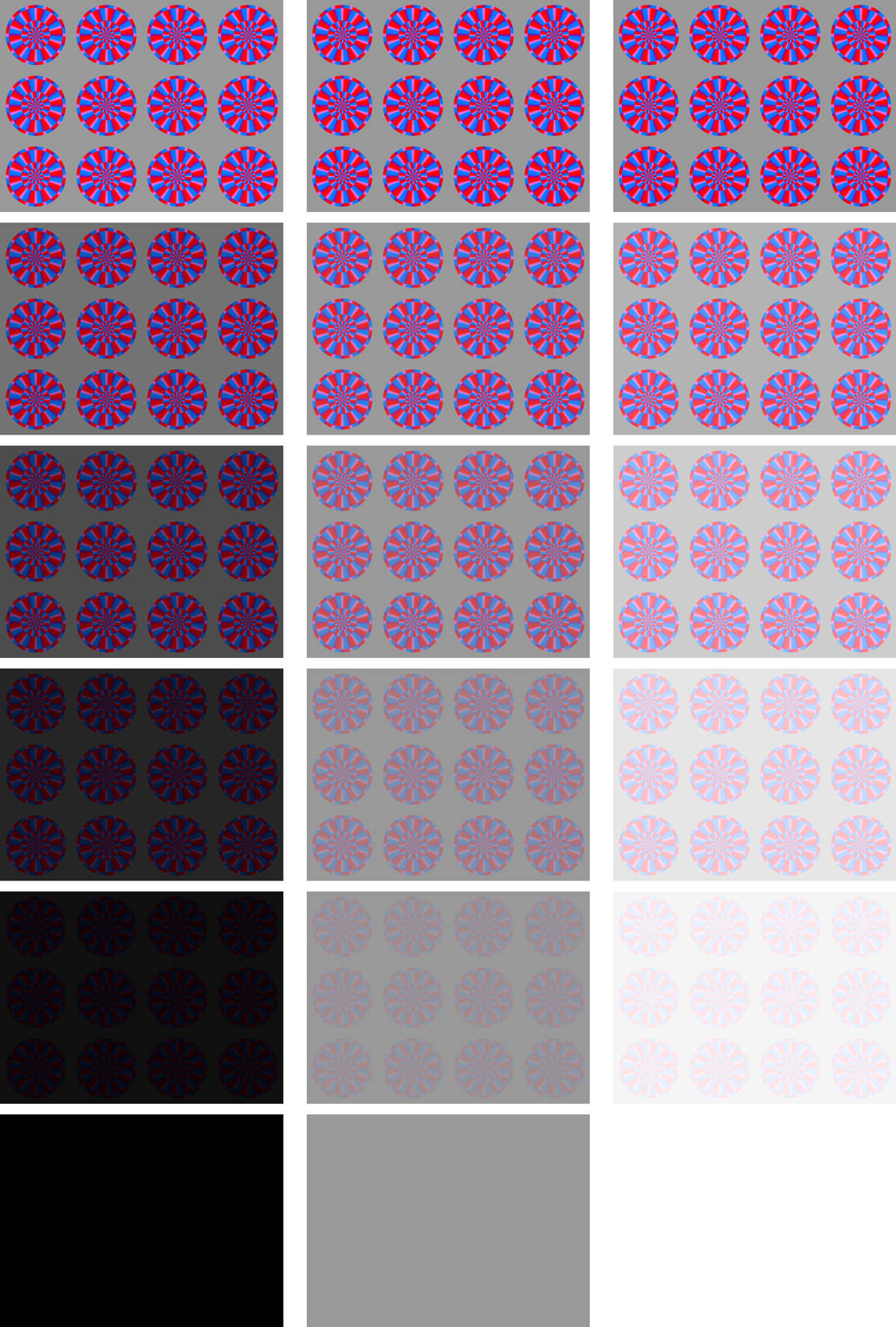
交替する背景は灰色のバージョンで、中間のフレームを1枚(50%透明・上図では中列の上から3つ目)のみとした動画。
ターゲットと灰色背景の単純な交替・・・円盤が消える時には回転感がある。
This study will be continued.
